Marketing Strategies of Target Corporation
VerifiedAdded on 2019/10/31
|27
|7593
|1718
Report
AI Summary
The provided content is a collection of various academic articles, books, and other resources that pertain to the themes of integrated marketing communications, retailing, international business, entrepreneurship, and strategic management. The works cover topics such as brand equity, consumer behavior, marketing strategies, innovation, and product development. There are also several case studies related to retail expansion into international markets, specifically focusing on Brazil and Canada. Additionally, some articles touch upon the importance of events in driving integrated marketing models and the role of social media in promoting products.
Contribute Materials
Your contribution can guide someone’s learning journey. Share your
documents today.
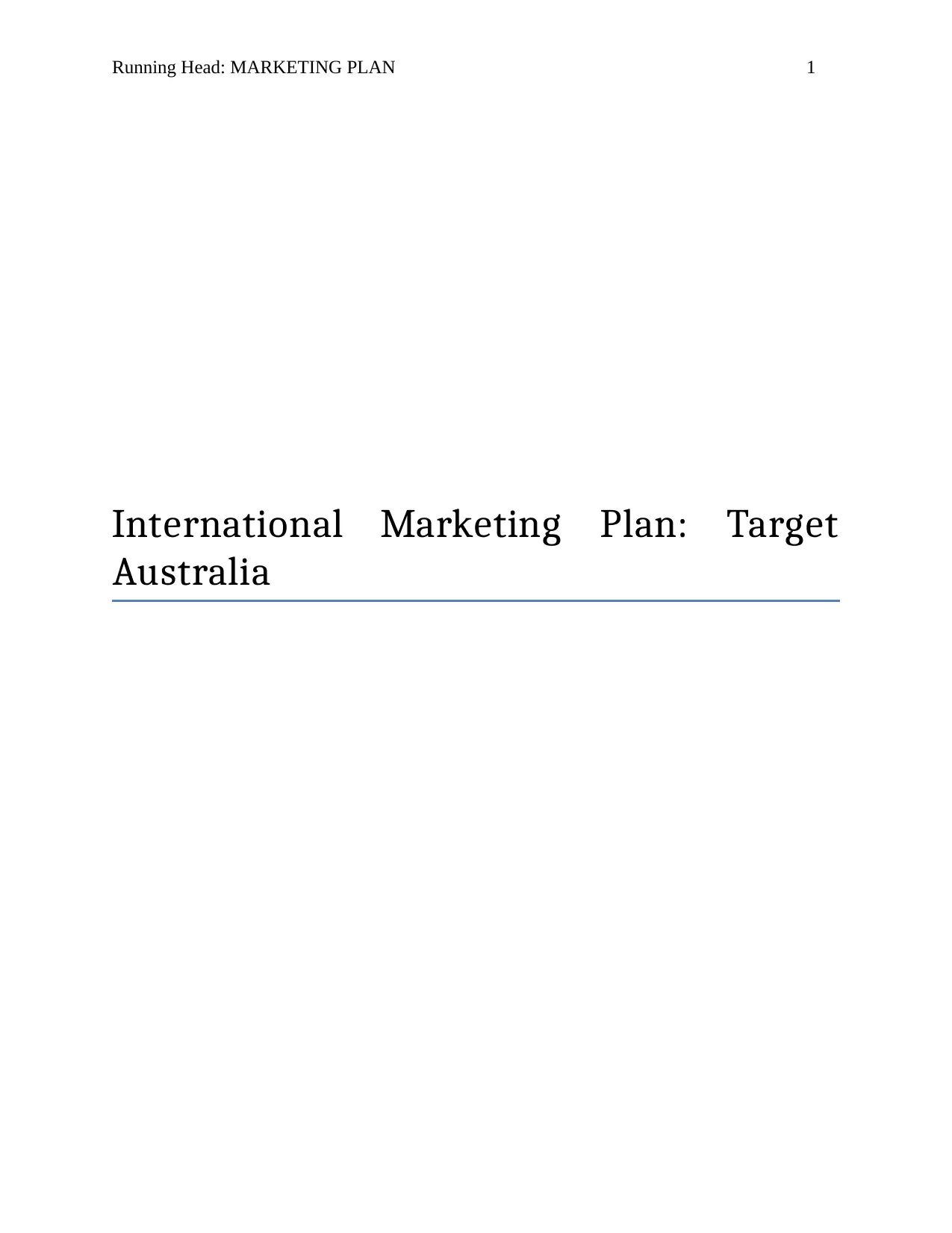
Running Head: MARKETING PLAN 1
International Marketing Plan: Target
Australia
International Marketing Plan: Target
Australia
Secure Best Marks with AI Grader
Need help grading? Try our AI Grader for instant feedback on your assignments.
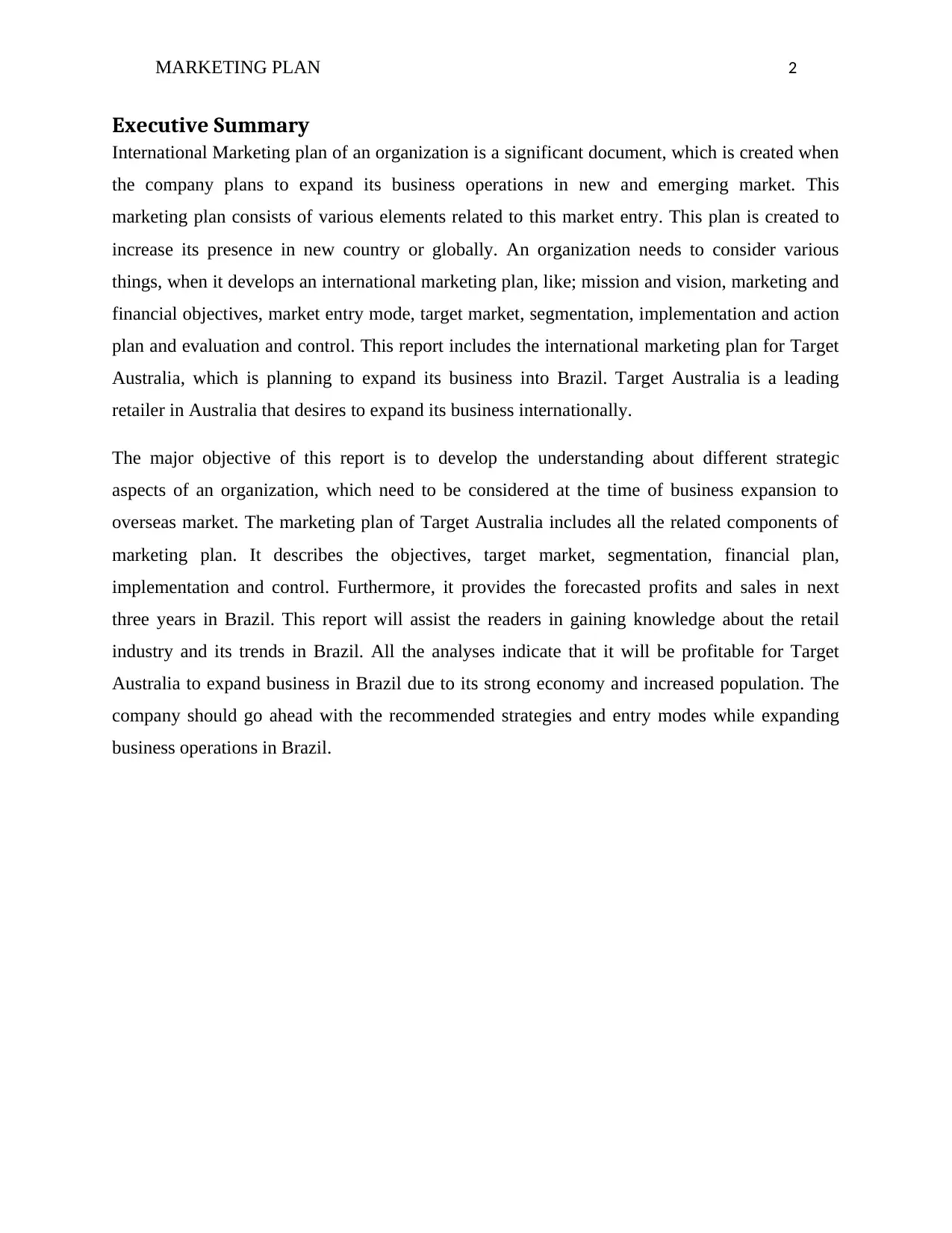
MARKETING PLAN 2
Executive Summary
International Marketing plan of an organization is a significant document, which is created when
the company plans to expand its business operations in new and emerging market. This
marketing plan consists of various elements related to this market entry. This plan is created to
increase its presence in new country or globally. An organization needs to consider various
things, when it develops an international marketing plan, like; mission and vision, marketing and
financial objectives, market entry mode, target market, segmentation, implementation and action
plan and evaluation and control. This report includes the international marketing plan for Target
Australia, which is planning to expand its business into Brazil. Target Australia is a leading
retailer in Australia that desires to expand its business internationally.
The major objective of this report is to develop the understanding about different strategic
aspects of an organization, which need to be considered at the time of business expansion to
overseas market. The marketing plan of Target Australia includes all the related components of
marketing plan. It describes the objectives, target market, segmentation, financial plan,
implementation and control. Furthermore, it provides the forecasted profits and sales in next
three years in Brazil. This report will assist the readers in gaining knowledge about the retail
industry and its trends in Brazil. All the analyses indicate that it will be profitable for Target
Australia to expand business in Brazil due to its strong economy and increased population. The
company should go ahead with the recommended strategies and entry modes while expanding
business operations in Brazil.
Executive Summary
International Marketing plan of an organization is a significant document, which is created when
the company plans to expand its business operations in new and emerging market. This
marketing plan consists of various elements related to this market entry. This plan is created to
increase its presence in new country or globally. An organization needs to consider various
things, when it develops an international marketing plan, like; mission and vision, marketing and
financial objectives, market entry mode, target market, segmentation, implementation and action
plan and evaluation and control. This report includes the international marketing plan for Target
Australia, which is planning to expand its business into Brazil. Target Australia is a leading
retailer in Australia that desires to expand its business internationally.
The major objective of this report is to develop the understanding about different strategic
aspects of an organization, which need to be considered at the time of business expansion to
overseas market. The marketing plan of Target Australia includes all the related components of
marketing plan. It describes the objectives, target market, segmentation, financial plan,
implementation and control. Furthermore, it provides the forecasted profits and sales in next
three years in Brazil. This report will assist the readers in gaining knowledge about the retail
industry and its trends in Brazil. All the analyses indicate that it will be profitable for Target
Australia to expand business in Brazil due to its strong economy and increased population. The
company should go ahead with the recommended strategies and entry modes while expanding
business operations in Brazil.
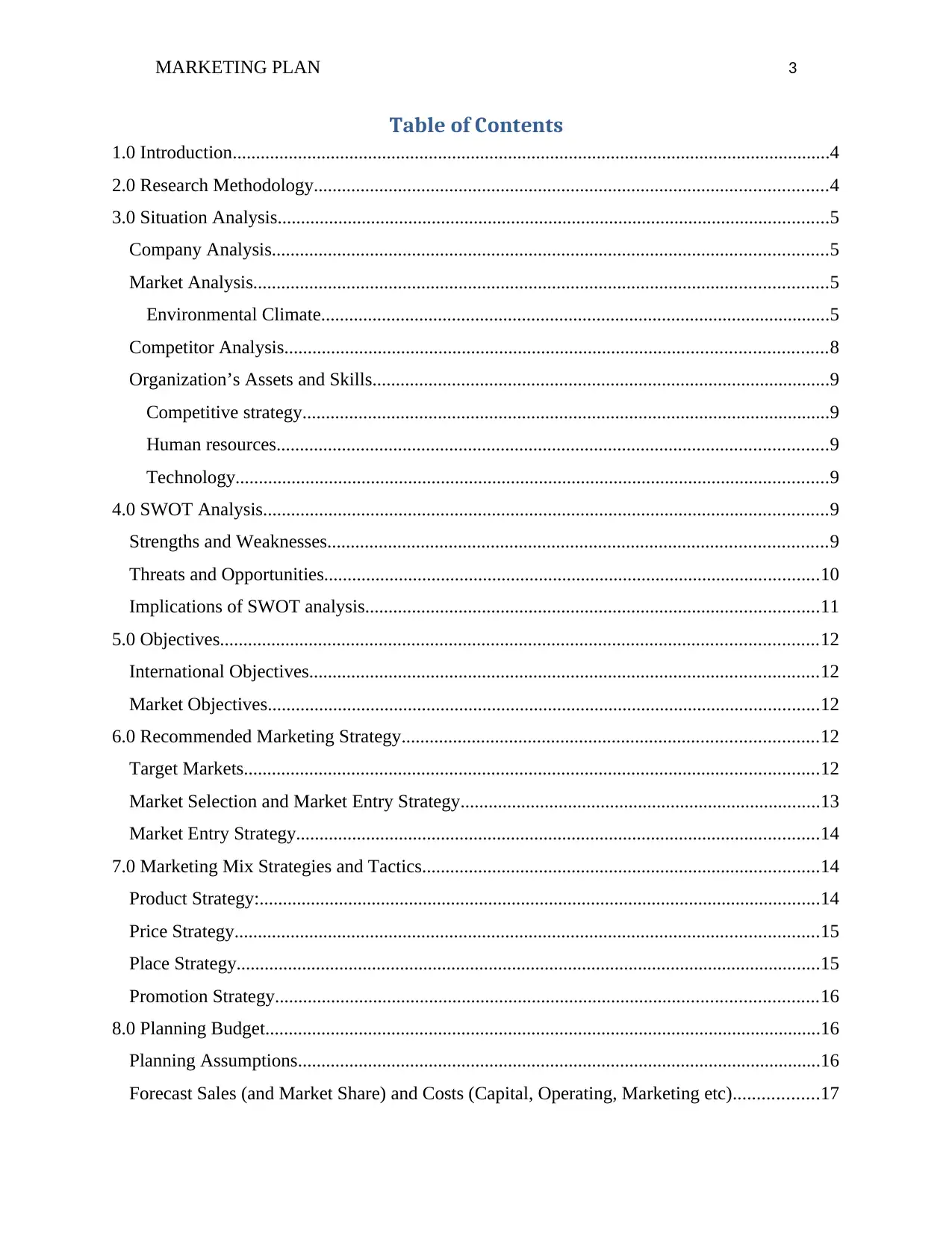
MARKETING PLAN 3
Table of Contents
1.0 Introduction................................................................................................................................4
2.0 Research Methodology..............................................................................................................4
3.0 Situation Analysis......................................................................................................................5
Company Analysis.......................................................................................................................5
Market Analysis...........................................................................................................................5
Environmental Climate.............................................................................................................5
Competitor Analysis....................................................................................................................8
Organization’s Assets and Skills..................................................................................................9
Competitive strategy.................................................................................................................9
Human resources......................................................................................................................9
Technology...............................................................................................................................9
4.0 SWOT Analysis.........................................................................................................................9
Strengths and Weaknesses...........................................................................................................9
Threats and Opportunities..........................................................................................................10
Implications of SWOT analysis.................................................................................................11
5.0 Objectives................................................................................................................................12
International Objectives.............................................................................................................12
Market Objectives......................................................................................................................12
6.0 Recommended Marketing Strategy.........................................................................................12
Target Markets...........................................................................................................................12
Market Selection and Market Entry Strategy.............................................................................13
Market Entry Strategy................................................................................................................14
7.0 Marketing Mix Strategies and Tactics.....................................................................................14
Product Strategy:........................................................................................................................14
Price Strategy.............................................................................................................................15
Place Strategy.............................................................................................................................15
Promotion Strategy....................................................................................................................16
8.0 Planning Budget.......................................................................................................................16
Planning Assumptions................................................................................................................16
Forecast Sales (and Market Share) and Costs (Capital, Operating, Marketing etc)..................17
Table of Contents
1.0 Introduction................................................................................................................................4
2.0 Research Methodology..............................................................................................................4
3.0 Situation Analysis......................................................................................................................5
Company Analysis.......................................................................................................................5
Market Analysis...........................................................................................................................5
Environmental Climate.............................................................................................................5
Competitor Analysis....................................................................................................................8
Organization’s Assets and Skills..................................................................................................9
Competitive strategy.................................................................................................................9
Human resources......................................................................................................................9
Technology...............................................................................................................................9
4.0 SWOT Analysis.........................................................................................................................9
Strengths and Weaknesses...........................................................................................................9
Threats and Opportunities..........................................................................................................10
Implications of SWOT analysis.................................................................................................11
5.0 Objectives................................................................................................................................12
International Objectives.............................................................................................................12
Market Objectives......................................................................................................................12
6.0 Recommended Marketing Strategy.........................................................................................12
Target Markets...........................................................................................................................12
Market Selection and Market Entry Strategy.............................................................................13
Market Entry Strategy................................................................................................................14
7.0 Marketing Mix Strategies and Tactics.....................................................................................14
Product Strategy:........................................................................................................................14
Price Strategy.............................................................................................................................15
Place Strategy.............................................................................................................................15
Promotion Strategy....................................................................................................................16
8.0 Planning Budget.......................................................................................................................16
Planning Assumptions................................................................................................................16
Forecast Sales (and Market Share) and Costs (Capital, Operating, Marketing etc)..................17
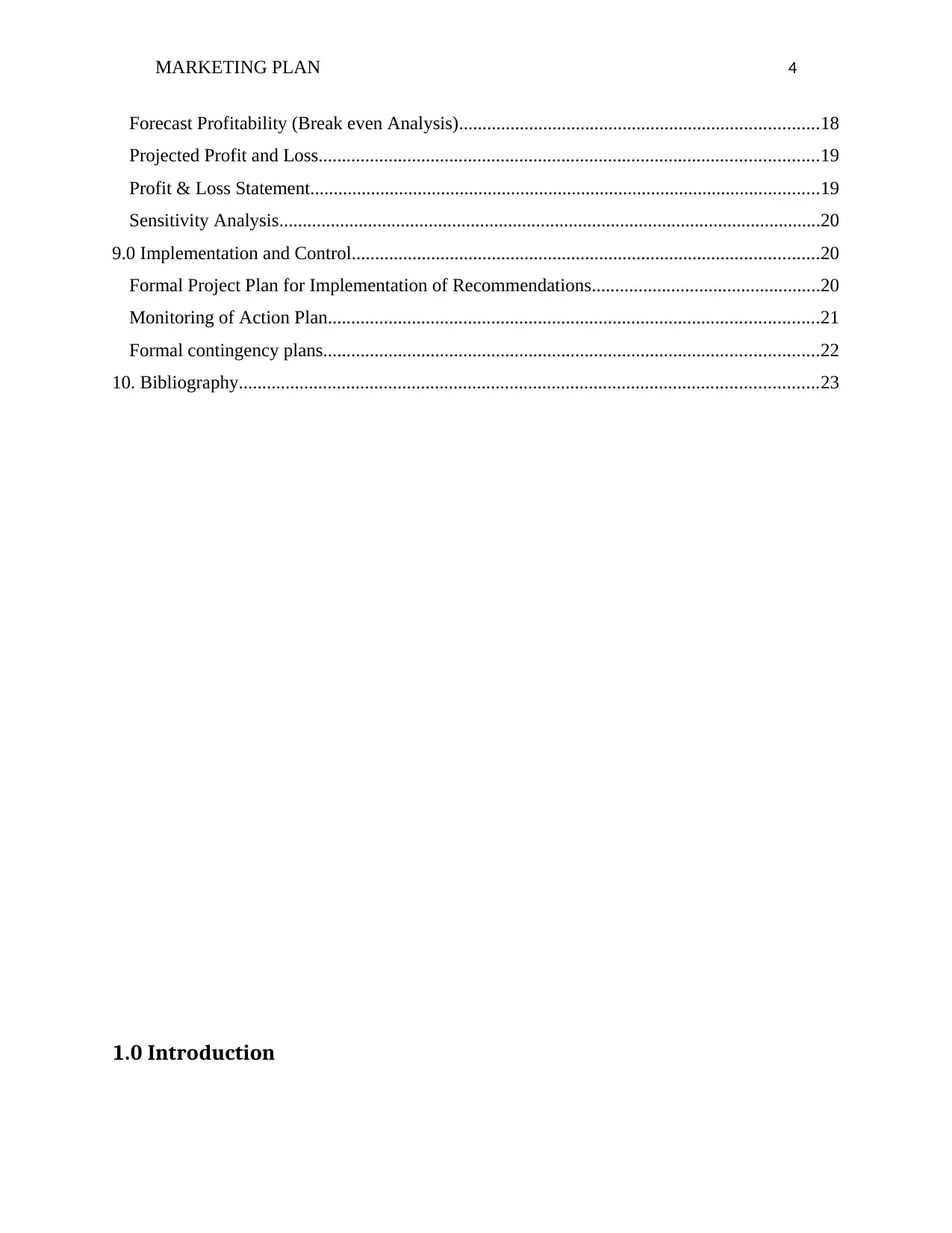
MARKETING PLAN 4
Forecast Profitability (Break even Analysis).............................................................................18
Projected Profit and Loss...........................................................................................................19
Profit & Loss Statement.............................................................................................................19
Sensitivity Analysis....................................................................................................................20
9.0 Implementation and Control....................................................................................................20
Formal Project Plan for Implementation of Recommendations.................................................20
Monitoring of Action Plan.........................................................................................................21
Formal contingency plans..........................................................................................................22
10. Bibliography............................................................................................................................23
1.0 Introduction
Forecast Profitability (Break even Analysis).............................................................................18
Projected Profit and Loss...........................................................................................................19
Profit & Loss Statement.............................................................................................................19
Sensitivity Analysis....................................................................................................................20
9.0 Implementation and Control....................................................................................................20
Formal Project Plan for Implementation of Recommendations.................................................20
Monitoring of Action Plan.........................................................................................................21
Formal contingency plans..........................................................................................................22
10. Bibliography............................................................................................................................23
1.0 Introduction
Secure Best Marks with AI Grader
Need help grading? Try our AI Grader for instant feedback on your assignments.
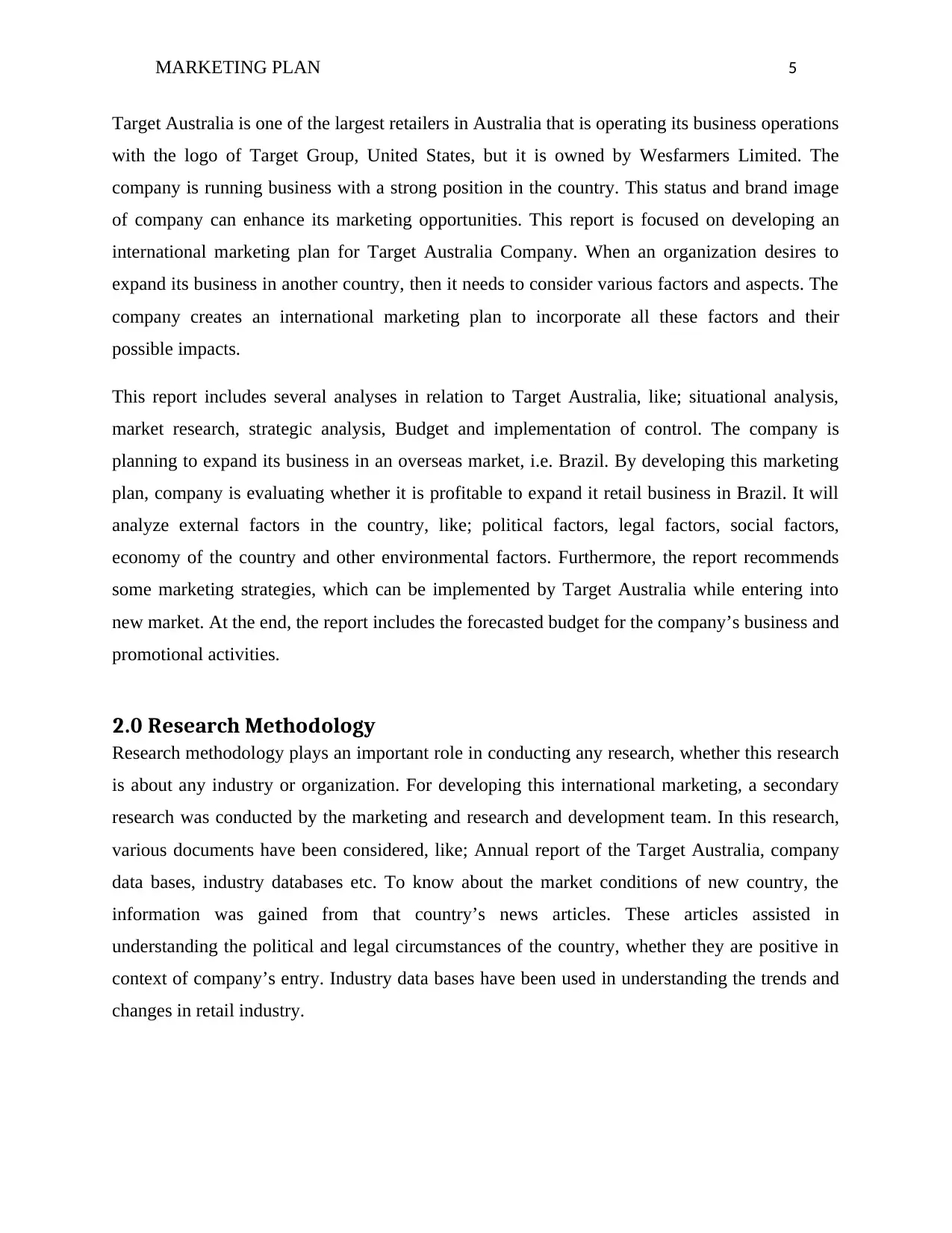
MARKETING PLAN 5
Target Australia is one of the largest retailers in Australia that is operating its business operations
with the logo of Target Group, United States, but it is owned by Wesfarmers Limited. The
company is running business with a strong position in the country. This status and brand image
of company can enhance its marketing opportunities. This report is focused on developing an
international marketing plan for Target Australia Company. When an organization desires to
expand its business in another country, then it needs to consider various factors and aspects. The
company creates an international marketing plan to incorporate all these factors and their
possible impacts.
This report includes several analyses in relation to Target Australia, like; situational analysis,
market research, strategic analysis, Budget and implementation of control. The company is
planning to expand its business in an overseas market, i.e. Brazil. By developing this marketing
plan, company is evaluating whether it is profitable to expand it retail business in Brazil. It will
analyze external factors in the country, like; political factors, legal factors, social factors,
economy of the country and other environmental factors. Furthermore, the report recommends
some marketing strategies, which can be implemented by Target Australia while entering into
new market. At the end, the report includes the forecasted budget for the company’s business and
promotional activities.
2.0 Research Methodology
Research methodology plays an important role in conducting any research, whether this research
is about any industry or organization. For developing this international marketing, a secondary
research was conducted by the marketing and research and development team. In this research,
various documents have been considered, like; Annual report of the Target Australia, company
data bases, industry databases etc. To know about the market conditions of new country, the
information was gained from that country’s news articles. These articles assisted in
understanding the political and legal circumstances of the country, whether they are positive in
context of company’s entry. Industry data bases have been used in understanding the trends and
changes in retail industry.
Target Australia is one of the largest retailers in Australia that is operating its business operations
with the logo of Target Group, United States, but it is owned by Wesfarmers Limited. The
company is running business with a strong position in the country. This status and brand image
of company can enhance its marketing opportunities. This report is focused on developing an
international marketing plan for Target Australia Company. When an organization desires to
expand its business in another country, then it needs to consider various factors and aspects. The
company creates an international marketing plan to incorporate all these factors and their
possible impacts.
This report includes several analyses in relation to Target Australia, like; situational analysis,
market research, strategic analysis, Budget and implementation of control. The company is
planning to expand its business in an overseas market, i.e. Brazil. By developing this marketing
plan, company is evaluating whether it is profitable to expand it retail business in Brazil. It will
analyze external factors in the country, like; political factors, legal factors, social factors,
economy of the country and other environmental factors. Furthermore, the report recommends
some marketing strategies, which can be implemented by Target Australia while entering into
new market. At the end, the report includes the forecasted budget for the company’s business and
promotional activities.
2.0 Research Methodology
Research methodology plays an important role in conducting any research, whether this research
is about any industry or organization. For developing this international marketing, a secondary
research was conducted by the marketing and research and development team. In this research,
various documents have been considered, like; Annual report of the Target Australia, company
data bases, industry databases etc. To know about the market conditions of new country, the
information was gained from that country’s news articles. These articles assisted in
understanding the political and legal circumstances of the country, whether they are positive in
context of company’s entry. Industry data bases have been used in understanding the trends and
changes in retail industry.
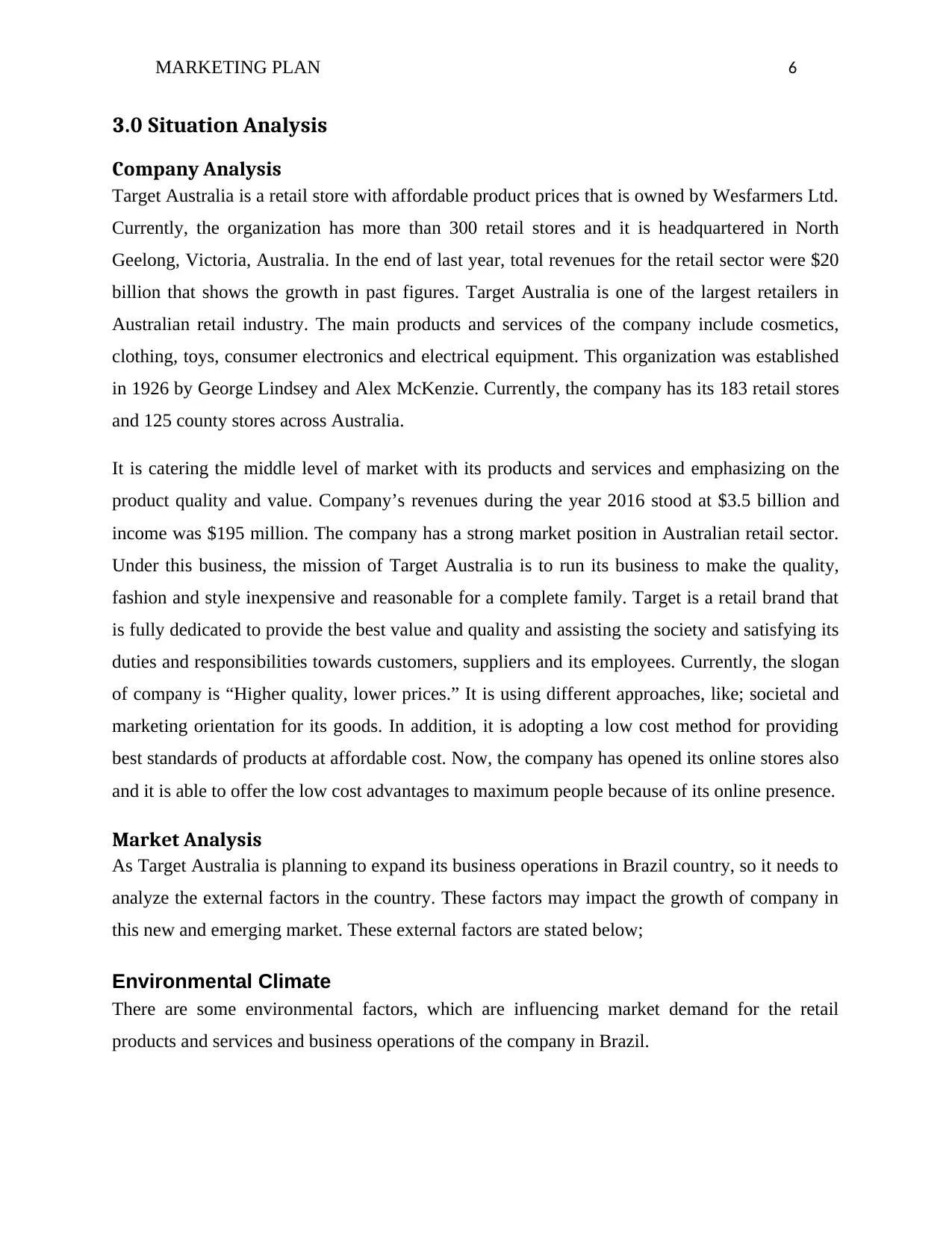
MARKETING PLAN 6
3.0 Situation Analysis
Company Analysis
Target Australia is a retail store with affordable product prices that is owned by Wesfarmers Ltd.
Currently, the organization has more than 300 retail stores and it is headquartered in North
Geelong, Victoria, Australia. In the end of last year, total revenues for the retail sector were $20
billion that shows the growth in past figures. Target Australia is one of the largest retailers in
Australian retail industry. The main products and services of the company include cosmetics,
clothing, toys, consumer electronics and electrical equipment. This organization was established
in 1926 by George Lindsey and Alex McKenzie. Currently, the company has its 183 retail stores
and 125 county stores across Australia.
It is catering the middle level of market with its products and services and emphasizing on the
product quality and value. Company’s revenues during the year 2016 stood at $3.5 billion and
income was $195 million. The company has a strong market position in Australian retail sector.
Under this business, the mission of Target Australia is to run its business to make the quality,
fashion and style inexpensive and reasonable for a complete family. Target is a retail brand that
is fully dedicated to provide the best value and quality and assisting the society and satisfying its
duties and responsibilities towards customers, suppliers and its employees. Currently, the slogan
of company is “Higher quality, lower prices.” It is using different approaches, like; societal and
marketing orientation for its goods. In addition, it is adopting a low cost method for providing
best standards of products at affordable cost. Now, the company has opened its online stores also
and it is able to offer the low cost advantages to maximum people because of its online presence.
Market Analysis
As Target Australia is planning to expand its business operations in Brazil country, so it needs to
analyze the external factors in the country. These factors may impact the growth of company in
this new and emerging market. These external factors are stated below;
Environmental Climate
There are some environmental factors, which are influencing market demand for the retail
products and services and business operations of the company in Brazil.
3.0 Situation Analysis
Company Analysis
Target Australia is a retail store with affordable product prices that is owned by Wesfarmers Ltd.
Currently, the organization has more than 300 retail stores and it is headquartered in North
Geelong, Victoria, Australia. In the end of last year, total revenues for the retail sector were $20
billion that shows the growth in past figures. Target Australia is one of the largest retailers in
Australian retail industry. The main products and services of the company include cosmetics,
clothing, toys, consumer electronics and electrical equipment. This organization was established
in 1926 by George Lindsey and Alex McKenzie. Currently, the company has its 183 retail stores
and 125 county stores across Australia.
It is catering the middle level of market with its products and services and emphasizing on the
product quality and value. Company’s revenues during the year 2016 stood at $3.5 billion and
income was $195 million. The company has a strong market position in Australian retail sector.
Under this business, the mission of Target Australia is to run its business to make the quality,
fashion and style inexpensive and reasonable for a complete family. Target is a retail brand that
is fully dedicated to provide the best value and quality and assisting the society and satisfying its
duties and responsibilities towards customers, suppliers and its employees. Currently, the slogan
of company is “Higher quality, lower prices.” It is using different approaches, like; societal and
marketing orientation for its goods. In addition, it is adopting a low cost method for providing
best standards of products at affordable cost. Now, the company has opened its online stores also
and it is able to offer the low cost advantages to maximum people because of its online presence.
Market Analysis
As Target Australia is planning to expand its business operations in Brazil country, so it needs to
analyze the external factors in the country. These factors may impact the growth of company in
this new and emerging market. These external factors are stated below;
Environmental Climate
There are some environmental factors, which are influencing market demand for the retail
products and services and business operations of the company in Brazil.
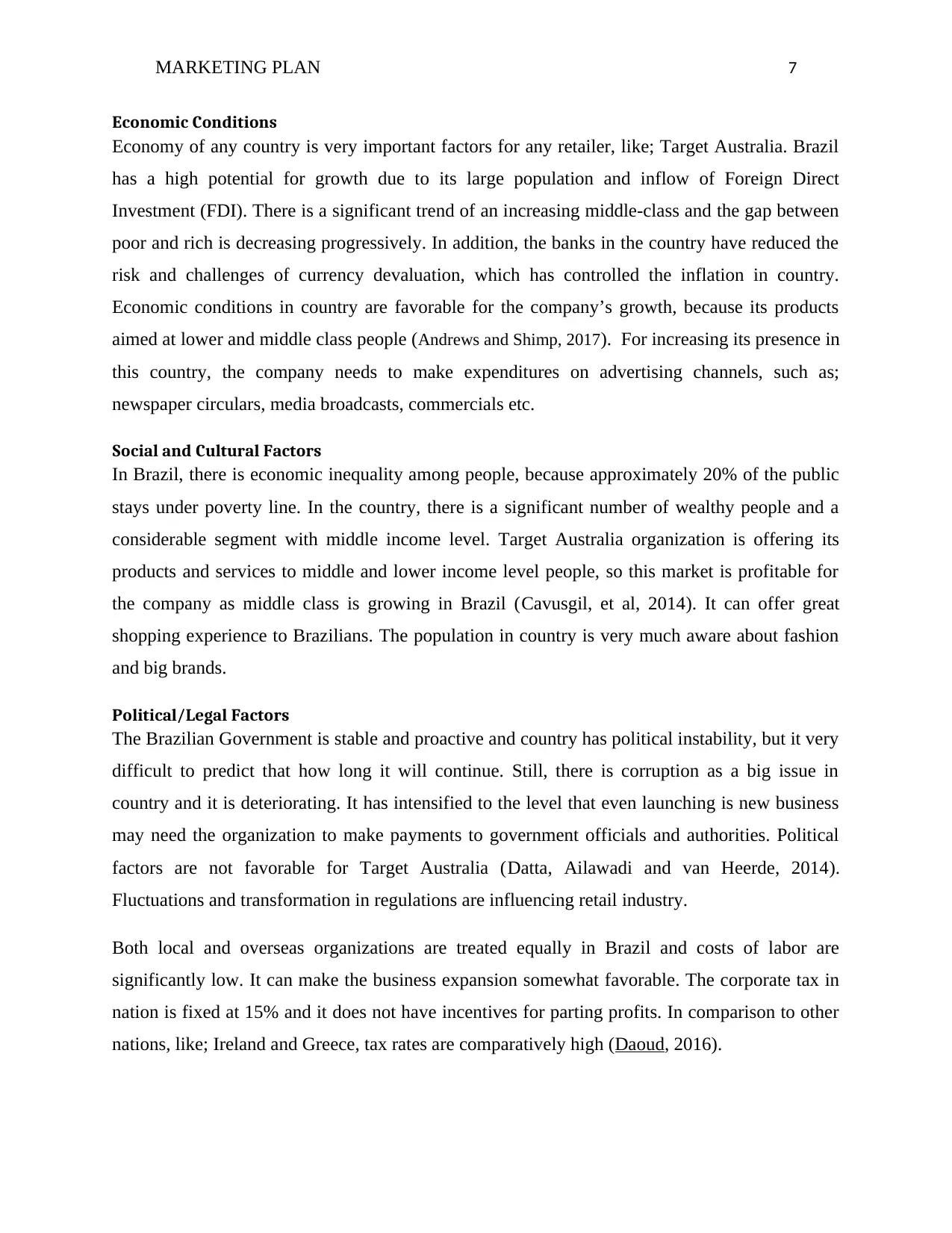
MARKETING PLAN 7
Economic Conditions
Economy of any country is very important factors for any retailer, like; Target Australia. Brazil
has a high potential for growth due to its large population and inflow of Foreign Direct
Investment (FDI). There is a significant trend of an increasing middle-class and the gap between
poor and rich is decreasing progressively. In addition, the banks in the country have reduced the
risk and challenges of currency devaluation, which has controlled the inflation in country.
Economic conditions in country are favorable for the company’s growth, because its products
aimed at lower and middle class people (Andrews and Shimp, 2017). For increasing its presence in
this country, the company needs to make expenditures on advertising channels, such as;
newspaper circulars, media broadcasts, commercials etc.
Social and Cultural Factors
In Brazil, there is economic inequality among people, because approximately 20% of the public
stays under poverty line. In the country, there is a significant number of wealthy people and a
considerable segment with middle income level. Target Australia organization is offering its
products and services to middle and lower income level people, so this market is profitable for
the company as middle class is growing in Brazil (Cavusgil, et al, 2014). It can offer great
shopping experience to Brazilians. The population in country is very much aware about fashion
and big brands.
Political/Legal Factors
The Brazilian Government is stable and proactive and country has political instability, but it very
difficult to predict that how long it will continue. Still, there is corruption as a big issue in
country and it is deteriorating. It has intensified to the level that even launching is new business
may need the organization to make payments to government officials and authorities. Political
factors are not favorable for Target Australia (Datta, Ailawadi and van Heerde, 2014).
Fluctuations and transformation in regulations are influencing retail industry.
Both local and overseas organizations are treated equally in Brazil and costs of labor are
significantly low. It can make the business expansion somewhat favorable. The corporate tax in
nation is fixed at 15% and it does not have incentives for parting profits. In comparison to other
nations, like; Ireland and Greece, tax rates are comparatively high (Daoud, 2016).
Economic Conditions
Economy of any country is very important factors for any retailer, like; Target Australia. Brazil
has a high potential for growth due to its large population and inflow of Foreign Direct
Investment (FDI). There is a significant trend of an increasing middle-class and the gap between
poor and rich is decreasing progressively. In addition, the banks in the country have reduced the
risk and challenges of currency devaluation, which has controlled the inflation in country.
Economic conditions in country are favorable for the company’s growth, because its products
aimed at lower and middle class people (Andrews and Shimp, 2017). For increasing its presence in
this country, the company needs to make expenditures on advertising channels, such as;
newspaper circulars, media broadcasts, commercials etc.
Social and Cultural Factors
In Brazil, there is economic inequality among people, because approximately 20% of the public
stays under poverty line. In the country, there is a significant number of wealthy people and a
considerable segment with middle income level. Target Australia organization is offering its
products and services to middle and lower income level people, so this market is profitable for
the company as middle class is growing in Brazil (Cavusgil, et al, 2014). It can offer great
shopping experience to Brazilians. The population in country is very much aware about fashion
and big brands.
Political/Legal Factors
The Brazilian Government is stable and proactive and country has political instability, but it very
difficult to predict that how long it will continue. Still, there is corruption as a big issue in
country and it is deteriorating. It has intensified to the level that even launching is new business
may need the organization to make payments to government officials and authorities. Political
factors are not favorable for Target Australia (Datta, Ailawadi and van Heerde, 2014).
Fluctuations and transformation in regulations are influencing retail industry.
Both local and overseas organizations are treated equally in Brazil and costs of labor are
significantly low. It can make the business expansion somewhat favorable. The corporate tax in
nation is fixed at 15% and it does not have incentives for parting profits. In comparison to other
nations, like; Ireland and Greece, tax rates are comparatively high (Daoud, 2016).
Paraphrase This Document
Need a fresh take? Get an instant paraphrase of this document with our AI Paraphraser
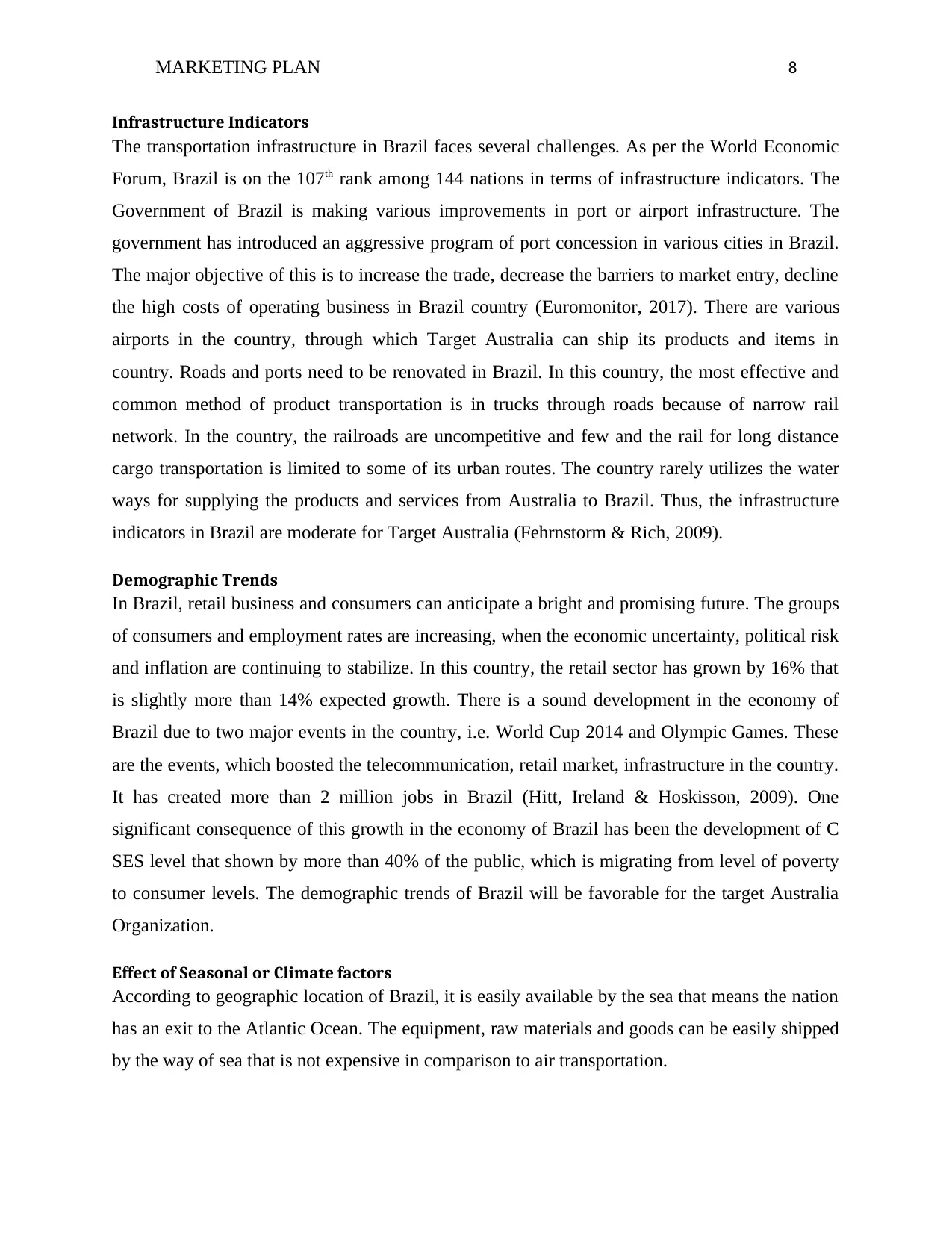
MARKETING PLAN 8
Infrastructure Indicators
The transportation infrastructure in Brazil faces several challenges. As per the World Economic
Forum, Brazil is on the 107th rank among 144 nations in terms of infrastructure indicators. The
Government of Brazil is making various improvements in port or airport infrastructure. The
government has introduced an aggressive program of port concession in various cities in Brazil.
The major objective of this is to increase the trade, decrease the barriers to market entry, decline
the high costs of operating business in Brazil country (Euromonitor, 2017). There are various
airports in the country, through which Target Australia can ship its products and items in
country. Roads and ports need to be renovated in Brazil. In this country, the most effective and
common method of product transportation is in trucks through roads because of narrow rail
network. In the country, the railroads are uncompetitive and few and the rail for long distance
cargo transportation is limited to some of its urban routes. The country rarely utilizes the water
ways for supplying the products and services from Australia to Brazil. Thus, the infrastructure
indicators in Brazil are moderate for Target Australia (Fehrnstorm & Rich, 2009).
Demographic Trends
In Brazil, retail business and consumers can anticipate a bright and promising future. The groups
of consumers and employment rates are increasing, when the economic uncertainty, political risk
and inflation are continuing to stabilize. In this country, the retail sector has grown by 16% that
is slightly more than 14% expected growth. There is a sound development in the economy of
Brazil due to two major events in the country, i.e. World Cup 2014 and Olympic Games. These
are the events, which boosted the telecommunication, retail market, infrastructure in the country.
It has created more than 2 million jobs in Brazil (Hitt, Ireland & Hoskisson, 2009). One
significant consequence of this growth in the economy of Brazil has been the development of C
SES level that shown by more than 40% of the public, which is migrating from level of poverty
to consumer levels. The demographic trends of Brazil will be favorable for the target Australia
Organization.
Effect of Seasonal or Climate factors
According to geographic location of Brazil, it is easily available by the sea that means the nation
has an exit to the Atlantic Ocean. The equipment, raw materials and goods can be easily shipped
by the way of sea that is not expensive in comparison to air transportation.
Infrastructure Indicators
The transportation infrastructure in Brazil faces several challenges. As per the World Economic
Forum, Brazil is on the 107th rank among 144 nations in terms of infrastructure indicators. The
Government of Brazil is making various improvements in port or airport infrastructure. The
government has introduced an aggressive program of port concession in various cities in Brazil.
The major objective of this is to increase the trade, decrease the barriers to market entry, decline
the high costs of operating business in Brazil country (Euromonitor, 2017). There are various
airports in the country, through which Target Australia can ship its products and items in
country. Roads and ports need to be renovated in Brazil. In this country, the most effective and
common method of product transportation is in trucks through roads because of narrow rail
network. In the country, the railroads are uncompetitive and few and the rail for long distance
cargo transportation is limited to some of its urban routes. The country rarely utilizes the water
ways for supplying the products and services from Australia to Brazil. Thus, the infrastructure
indicators in Brazil are moderate for Target Australia (Fehrnstorm & Rich, 2009).
Demographic Trends
In Brazil, retail business and consumers can anticipate a bright and promising future. The groups
of consumers and employment rates are increasing, when the economic uncertainty, political risk
and inflation are continuing to stabilize. In this country, the retail sector has grown by 16% that
is slightly more than 14% expected growth. There is a sound development in the economy of
Brazil due to two major events in the country, i.e. World Cup 2014 and Olympic Games. These
are the events, which boosted the telecommunication, retail market, infrastructure in the country.
It has created more than 2 million jobs in Brazil (Hitt, Ireland & Hoskisson, 2009). One
significant consequence of this growth in the economy of Brazil has been the development of C
SES level that shown by more than 40% of the public, which is migrating from level of poverty
to consumer levels. The demographic trends of Brazil will be favorable for the target Australia
Organization.
Effect of Seasonal or Climate factors
According to geographic location of Brazil, it is easily available by the sea that means the nation
has an exit to the Atlantic Ocean. The equipment, raw materials and goods can be easily shipped
by the way of sea that is not expensive in comparison to air transportation.
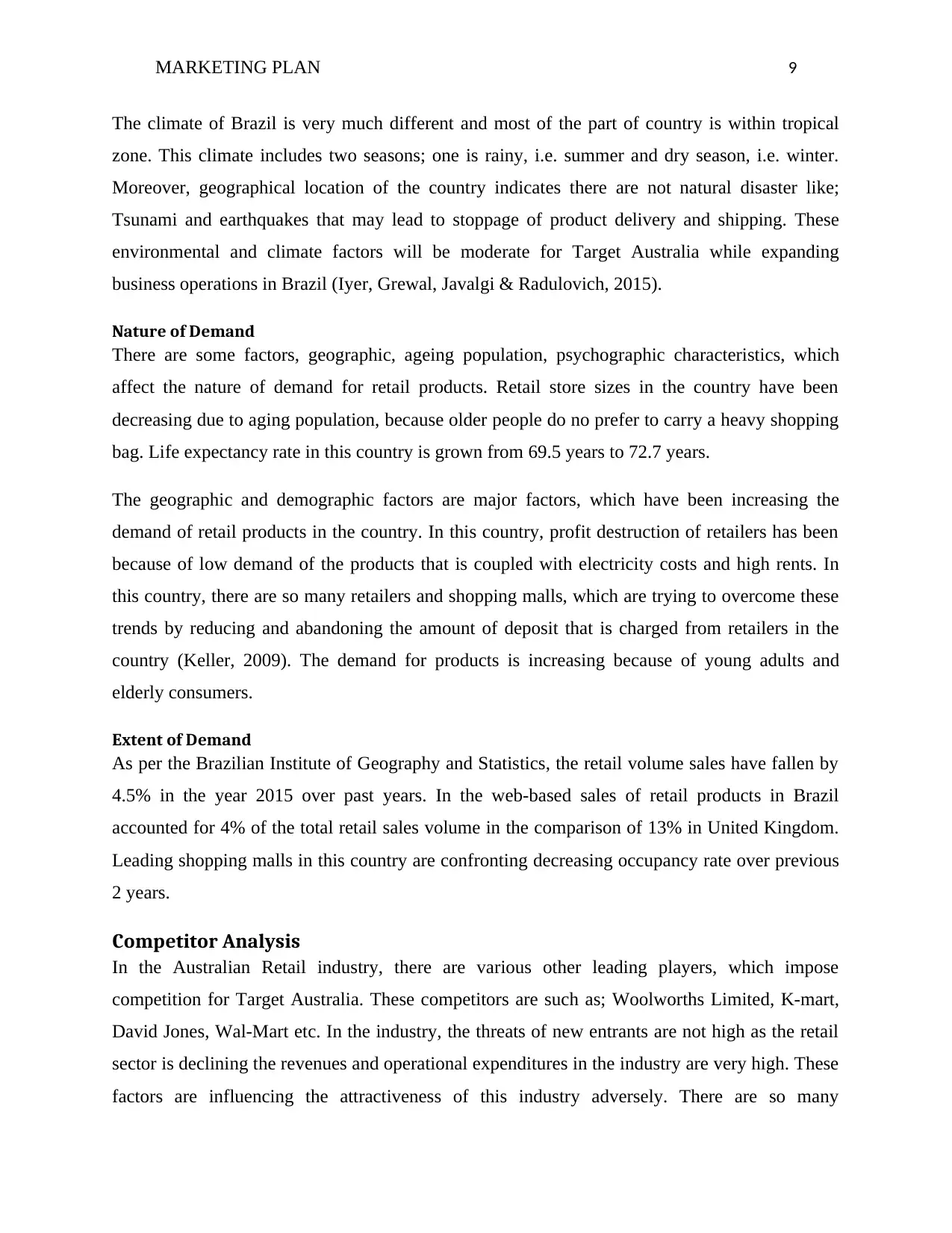
MARKETING PLAN 9
The climate of Brazil is very much different and most of the part of country is within tropical
zone. This climate includes two seasons; one is rainy, i.e. summer and dry season, i.e. winter.
Moreover, geographical location of the country indicates there are not natural disaster like;
Tsunami and earthquakes that may lead to stoppage of product delivery and shipping. These
environmental and climate factors will be moderate for Target Australia while expanding
business operations in Brazil (Iyer, Grewal, Javalgi & Radulovich, 2015).
Nature of Demand
There are some factors, geographic, ageing population, psychographic characteristics, which
affect the nature of demand for retail products. Retail store sizes in the country have been
decreasing due to aging population, because older people do no prefer to carry a heavy shopping
bag. Life expectancy rate in this country is grown from 69.5 years to 72.7 years.
The geographic and demographic factors are major factors, which have been increasing the
demand of retail products in the country. In this country, profit destruction of retailers has been
because of low demand of the products that is coupled with electricity costs and high rents. In
this country, there are so many retailers and shopping malls, which are trying to overcome these
trends by reducing and abandoning the amount of deposit that is charged from retailers in the
country (Keller, 2009). The demand for products is increasing because of young adults and
elderly consumers.
Extent of Demand
As per the Brazilian Institute of Geography and Statistics, the retail volume sales have fallen by
4.5% in the year 2015 over past years. In the web-based sales of retail products in Brazil
accounted for 4% of the total retail sales volume in the comparison of 13% in United Kingdom.
Leading shopping malls in this country are confronting decreasing occupancy rate over previous
2 years.
Competitor Analysis
In the Australian Retail industry, there are various other leading players, which impose
competition for Target Australia. These competitors are such as; Woolworths Limited, K-mart,
David Jones, Wal-Mart etc. In the industry, the threats of new entrants are not high as the retail
sector is declining the revenues and operational expenditures in the industry are very high. These
factors are influencing the attractiveness of this industry adversely. There are so many
The climate of Brazil is very much different and most of the part of country is within tropical
zone. This climate includes two seasons; one is rainy, i.e. summer and dry season, i.e. winter.
Moreover, geographical location of the country indicates there are not natural disaster like;
Tsunami and earthquakes that may lead to stoppage of product delivery and shipping. These
environmental and climate factors will be moderate for Target Australia while expanding
business operations in Brazil (Iyer, Grewal, Javalgi & Radulovich, 2015).
Nature of Demand
There are some factors, geographic, ageing population, psychographic characteristics, which
affect the nature of demand for retail products. Retail store sizes in the country have been
decreasing due to aging population, because older people do no prefer to carry a heavy shopping
bag. Life expectancy rate in this country is grown from 69.5 years to 72.7 years.
The geographic and demographic factors are major factors, which have been increasing the
demand of retail products in the country. In this country, profit destruction of retailers has been
because of low demand of the products that is coupled with electricity costs and high rents. In
this country, there are so many retailers and shopping malls, which are trying to overcome these
trends by reducing and abandoning the amount of deposit that is charged from retailers in the
country (Keller, 2009). The demand for products is increasing because of young adults and
elderly consumers.
Extent of Demand
As per the Brazilian Institute of Geography and Statistics, the retail volume sales have fallen by
4.5% in the year 2015 over past years. In the web-based sales of retail products in Brazil
accounted for 4% of the total retail sales volume in the comparison of 13% in United Kingdom.
Leading shopping malls in this country are confronting decreasing occupancy rate over previous
2 years.
Competitor Analysis
In the Australian Retail industry, there are various other leading players, which impose
competition for Target Australia. These competitors are such as; Woolworths Limited, K-mart,
David Jones, Wal-Mart etc. In the industry, the threats of new entrants are not high as the retail
sector is declining the revenues and operational expenditures in the industry are very high. These
factors are influencing the attractiveness of this industry adversely. There are so many
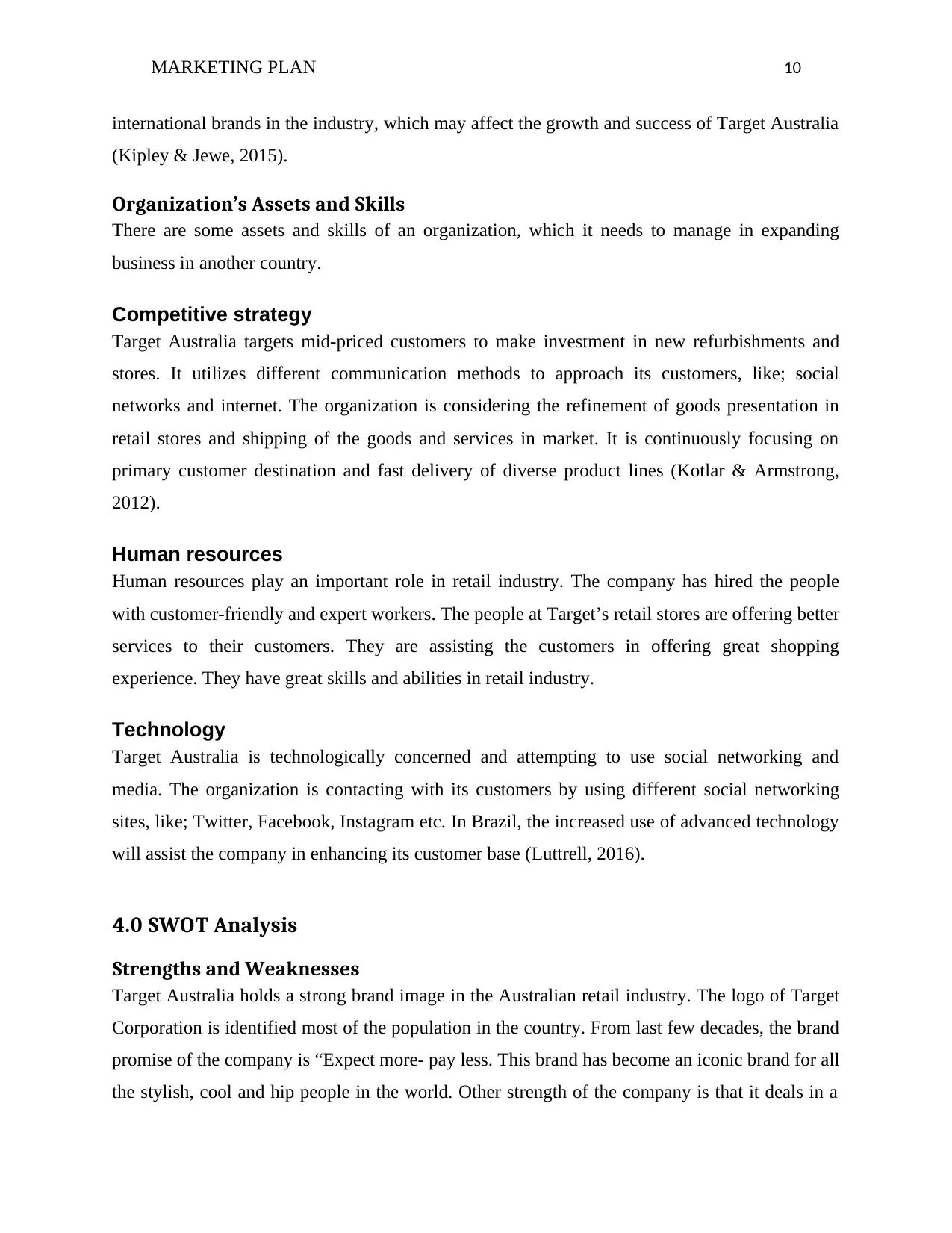
MARKETING PLAN 10
international brands in the industry, which may affect the growth and success of Target Australia
(Kipley & Jewe, 2015).
Organization’s Assets and Skills
There are some assets and skills of an organization, which it needs to manage in expanding
business in another country.
Competitive strategy
Target Australia targets mid-priced customers to make investment in new refurbishments and
stores. It utilizes different communication methods to approach its customers, like; social
networks and internet. The organization is considering the refinement of goods presentation in
retail stores and shipping of the goods and services in market. It is continuously focusing on
primary customer destination and fast delivery of diverse product lines (Kotlar & Armstrong,
2012).
Human resources
Human resources play an important role in retail industry. The company has hired the people
with customer-friendly and expert workers. The people at Target’s retail stores are offering better
services to their customers. They are assisting the customers in offering great shopping
experience. They have great skills and abilities in retail industry.
Technology
Target Australia is technologically concerned and attempting to use social networking and
media. The organization is contacting with its customers by using different social networking
sites, like; Twitter, Facebook, Instagram etc. In Brazil, the increased use of advanced technology
will assist the company in enhancing its customer base (Luttrell, 2016).
4.0 SWOT Analysis
Strengths and Weaknesses
Target Australia holds a strong brand image in the Australian retail industry. The logo of Target
Corporation is identified most of the population in the country. From last few decades, the brand
promise of the company is “Expect more- pay less. This brand has become an iconic brand for all
the stylish, cool and hip people in the world. Other strength of the company is that it deals in a
international brands in the industry, which may affect the growth and success of Target Australia
(Kipley & Jewe, 2015).
Organization’s Assets and Skills
There are some assets and skills of an organization, which it needs to manage in expanding
business in another country.
Competitive strategy
Target Australia targets mid-priced customers to make investment in new refurbishments and
stores. It utilizes different communication methods to approach its customers, like; social
networks and internet. The organization is considering the refinement of goods presentation in
retail stores and shipping of the goods and services in market. It is continuously focusing on
primary customer destination and fast delivery of diverse product lines (Kotlar & Armstrong,
2012).
Human resources
Human resources play an important role in retail industry. The company has hired the people
with customer-friendly and expert workers. The people at Target’s retail stores are offering better
services to their customers. They are assisting the customers in offering great shopping
experience. They have great skills and abilities in retail industry.
Technology
Target Australia is technologically concerned and attempting to use social networking and
media. The organization is contacting with its customers by using different social networking
sites, like; Twitter, Facebook, Instagram etc. In Brazil, the increased use of advanced technology
will assist the company in enhancing its customer base (Luttrell, 2016).
4.0 SWOT Analysis
Strengths and Weaknesses
Target Australia holds a strong brand image in the Australian retail industry. The logo of Target
Corporation is identified most of the population in the country. From last few decades, the brand
promise of the company is “Expect more- pay less. This brand has become an iconic brand for all
the stylish, cool and hip people in the world. Other strength of the company is that it deals in a
Secure Best Marks with AI Grader
Need help grading? Try our AI Grader for instant feedback on your assignments.
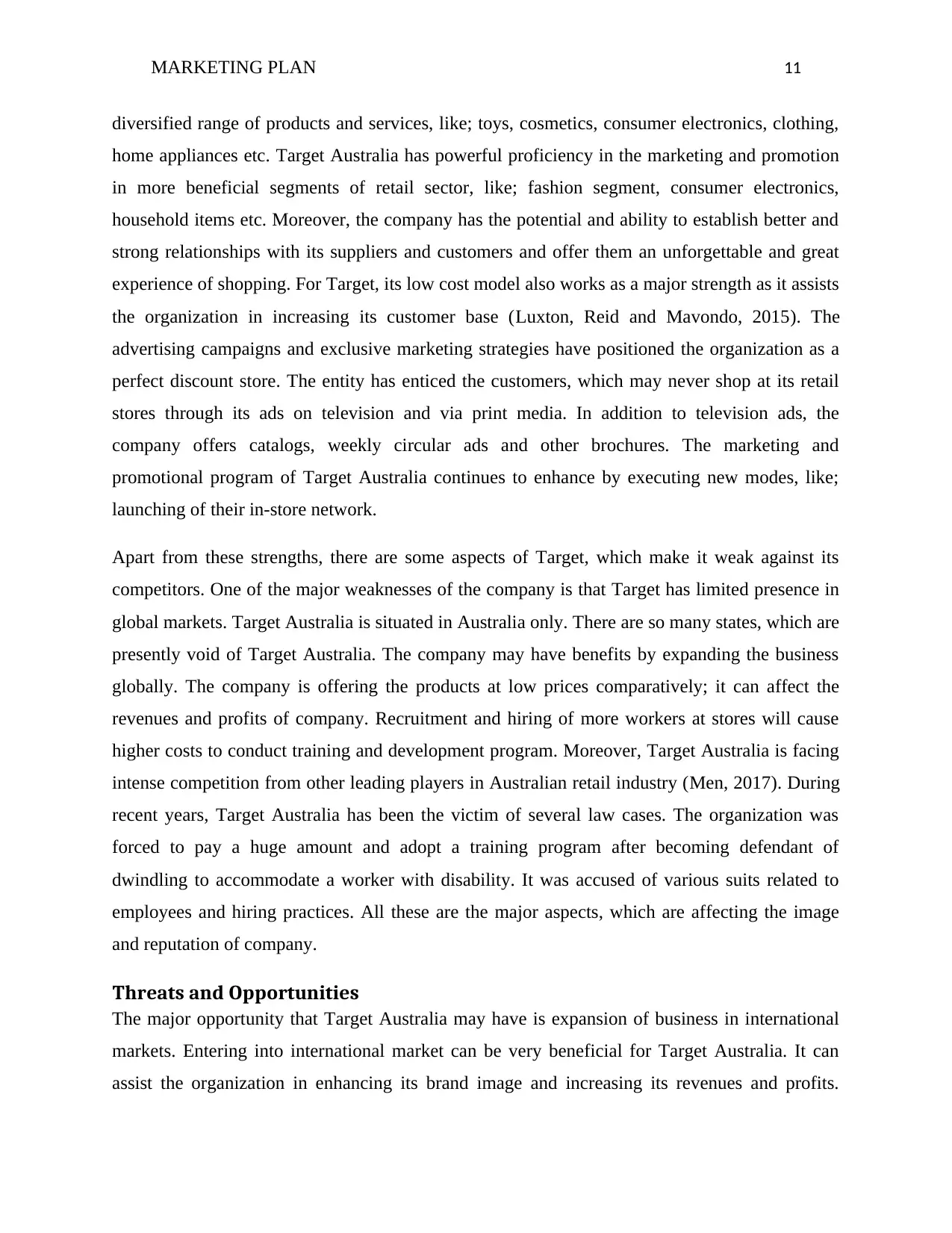
MARKETING PLAN 11
diversified range of products and services, like; toys, cosmetics, consumer electronics, clothing,
home appliances etc. Target Australia has powerful proficiency in the marketing and promotion
in more beneficial segments of retail sector, like; fashion segment, consumer electronics,
household items etc. Moreover, the company has the potential and ability to establish better and
strong relationships with its suppliers and customers and offer them an unforgettable and great
experience of shopping. For Target, its low cost model also works as a major strength as it assists
the organization in increasing its customer base (Luxton, Reid and Mavondo, 2015). The
advertising campaigns and exclusive marketing strategies have positioned the organization as a
perfect discount store. The entity has enticed the customers, which may never shop at its retail
stores through its ads on television and via print media. In addition to television ads, the
company offers catalogs, weekly circular ads and other brochures. The marketing and
promotional program of Target Australia continues to enhance by executing new modes, like;
launching of their in-store network.
Apart from these strengths, there are some aspects of Target, which make it weak against its
competitors. One of the major weaknesses of the company is that Target has limited presence in
global markets. Target Australia is situated in Australia only. There are so many states, which are
presently void of Target Australia. The company may have benefits by expanding the business
globally. The company is offering the products at low prices comparatively; it can affect the
revenues and profits of company. Recruitment and hiring of more workers at stores will cause
higher costs to conduct training and development program. Moreover, Target Australia is facing
intense competition from other leading players in Australian retail industry (Men, 2017). During
recent years, Target Australia has been the victim of several law cases. The organization was
forced to pay a huge amount and adopt a training program after becoming defendant of
dwindling to accommodate a worker with disability. It was accused of various suits related to
employees and hiring practices. All these are the major aspects, which are affecting the image
and reputation of company.
Threats and Opportunities
The major opportunity that Target Australia may have is expansion of business in international
markets. Entering into international market can be very beneficial for Target Australia. It can
assist the organization in enhancing its brand image and increasing its revenues and profits.
diversified range of products and services, like; toys, cosmetics, consumer electronics, clothing,
home appliances etc. Target Australia has powerful proficiency in the marketing and promotion
in more beneficial segments of retail sector, like; fashion segment, consumer electronics,
household items etc. Moreover, the company has the potential and ability to establish better and
strong relationships with its suppliers and customers and offer them an unforgettable and great
experience of shopping. For Target, its low cost model also works as a major strength as it assists
the organization in increasing its customer base (Luxton, Reid and Mavondo, 2015). The
advertising campaigns and exclusive marketing strategies have positioned the organization as a
perfect discount store. The entity has enticed the customers, which may never shop at its retail
stores through its ads on television and via print media. In addition to television ads, the
company offers catalogs, weekly circular ads and other brochures. The marketing and
promotional program of Target Australia continues to enhance by executing new modes, like;
launching of their in-store network.
Apart from these strengths, there are some aspects of Target, which make it weak against its
competitors. One of the major weaknesses of the company is that Target has limited presence in
global markets. Target Australia is situated in Australia only. There are so many states, which are
presently void of Target Australia. The company may have benefits by expanding the business
globally. The company is offering the products at low prices comparatively; it can affect the
revenues and profits of company. Recruitment and hiring of more workers at stores will cause
higher costs to conduct training and development program. Moreover, Target Australia is facing
intense competition from other leading players in Australian retail industry (Men, 2017). During
recent years, Target Australia has been the victim of several law cases. The organization was
forced to pay a huge amount and adopt a training program after becoming defendant of
dwindling to accommodate a worker with disability. It was accused of various suits related to
employees and hiring practices. All these are the major aspects, which are affecting the image
and reputation of company.
Threats and Opportunities
The major opportunity that Target Australia may have is expansion of business in international
markets. Entering into international market can be very beneficial for Target Australia. It can
assist the organization in enhancing its brand image and increasing its revenues and profits.
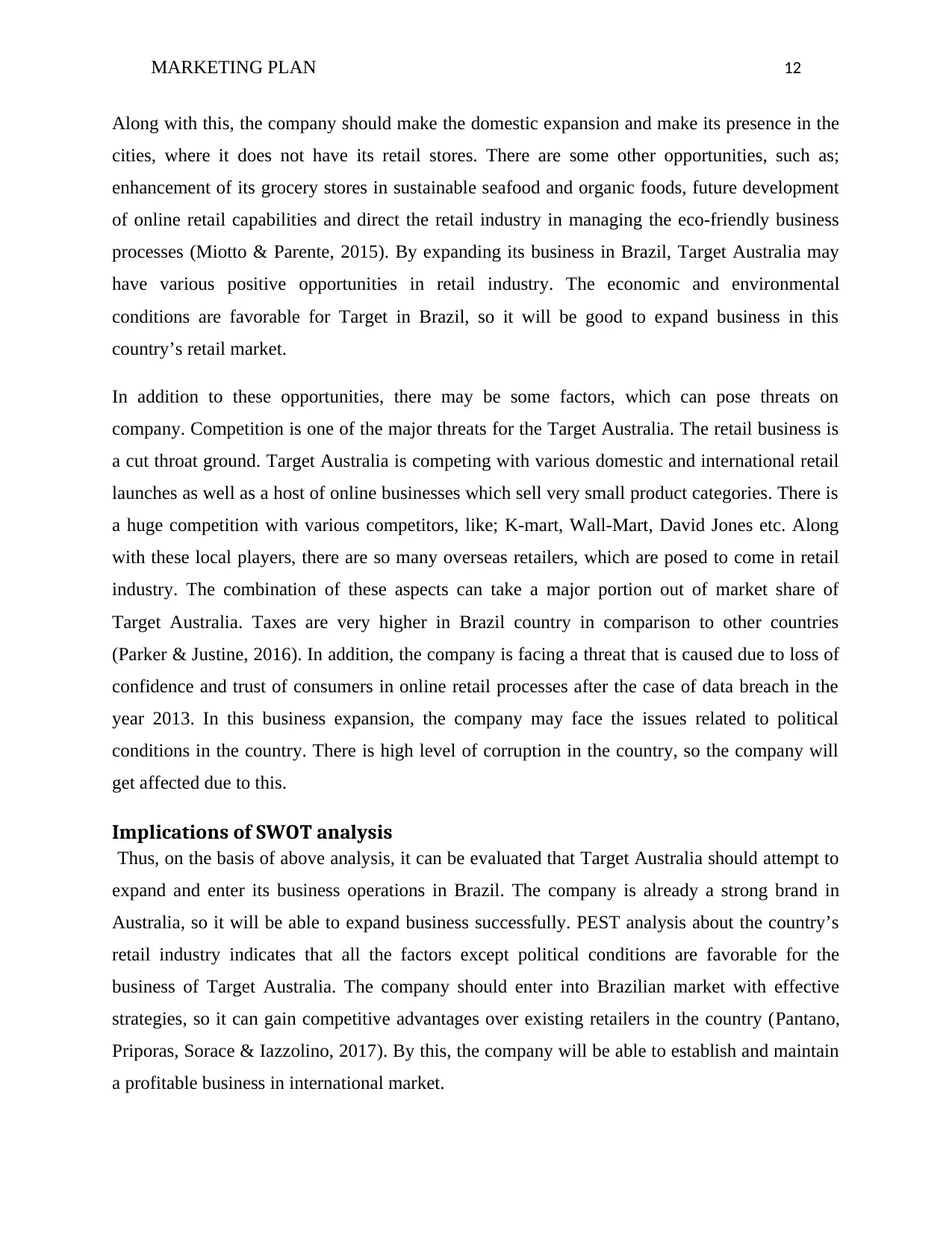
MARKETING PLAN 12
Along with this, the company should make the domestic expansion and make its presence in the
cities, where it does not have its retail stores. There are some other opportunities, such as;
enhancement of its grocery stores in sustainable seafood and organic foods, future development
of online retail capabilities and direct the retail industry in managing the eco-friendly business
processes (Miotto & Parente, 2015). By expanding its business in Brazil, Target Australia may
have various positive opportunities in retail industry. The economic and environmental
conditions are favorable for Target in Brazil, so it will be good to expand business in this
country’s retail market.
In addition to these opportunities, there may be some factors, which can pose threats on
company. Competition is one of the major threats for the Target Australia. The retail business is
a cut throat ground. Target Australia is competing with various domestic and international retail
launches as well as a host of online businesses which sell very small product categories. There is
a huge competition with various competitors, like; K-mart, Wall-Mart, David Jones etc. Along
with these local players, there are so many overseas retailers, which are posed to come in retail
industry. The combination of these aspects can take a major portion out of market share of
Target Australia. Taxes are very higher in Brazil country in comparison to other countries
(Parker & Justine, 2016). In addition, the company is facing a threat that is caused due to loss of
confidence and trust of consumers in online retail processes after the case of data breach in the
year 2013. In this business expansion, the company may face the issues related to political
conditions in the country. There is high level of corruption in the country, so the company will
get affected due to this.
Implications of SWOT analysis
Thus, on the basis of above analysis, it can be evaluated that Target Australia should attempt to
expand and enter its business operations in Brazil. The company is already a strong brand in
Australia, so it will be able to expand business successfully. PEST analysis about the country’s
retail industry indicates that all the factors except political conditions are favorable for the
business of Target Australia. The company should enter into Brazilian market with effective
strategies, so it can gain competitive advantages over existing retailers in the country (Pantano,
Priporas, Sorace & Iazzolino, 2017). By this, the company will be able to establish and maintain
a profitable business in international market.
Along with this, the company should make the domestic expansion and make its presence in the
cities, where it does not have its retail stores. There are some other opportunities, such as;
enhancement of its grocery stores in sustainable seafood and organic foods, future development
of online retail capabilities and direct the retail industry in managing the eco-friendly business
processes (Miotto & Parente, 2015). By expanding its business in Brazil, Target Australia may
have various positive opportunities in retail industry. The economic and environmental
conditions are favorable for Target in Brazil, so it will be good to expand business in this
country’s retail market.
In addition to these opportunities, there may be some factors, which can pose threats on
company. Competition is one of the major threats for the Target Australia. The retail business is
a cut throat ground. Target Australia is competing with various domestic and international retail
launches as well as a host of online businesses which sell very small product categories. There is
a huge competition with various competitors, like; K-mart, Wall-Mart, David Jones etc. Along
with these local players, there are so many overseas retailers, which are posed to come in retail
industry. The combination of these aspects can take a major portion out of market share of
Target Australia. Taxes are very higher in Brazil country in comparison to other countries
(Parker & Justine, 2016). In addition, the company is facing a threat that is caused due to loss of
confidence and trust of consumers in online retail processes after the case of data breach in the
year 2013. In this business expansion, the company may face the issues related to political
conditions in the country. There is high level of corruption in the country, so the company will
get affected due to this.
Implications of SWOT analysis
Thus, on the basis of above analysis, it can be evaluated that Target Australia should attempt to
expand and enter its business operations in Brazil. The company is already a strong brand in
Australia, so it will be able to expand business successfully. PEST analysis about the country’s
retail industry indicates that all the factors except political conditions are favorable for the
business of Target Australia. The company should enter into Brazilian market with effective
strategies, so it can gain competitive advantages over existing retailers in the country (Pantano,
Priporas, Sorace & Iazzolino, 2017). By this, the company will be able to establish and maintain
a profitable business in international market.
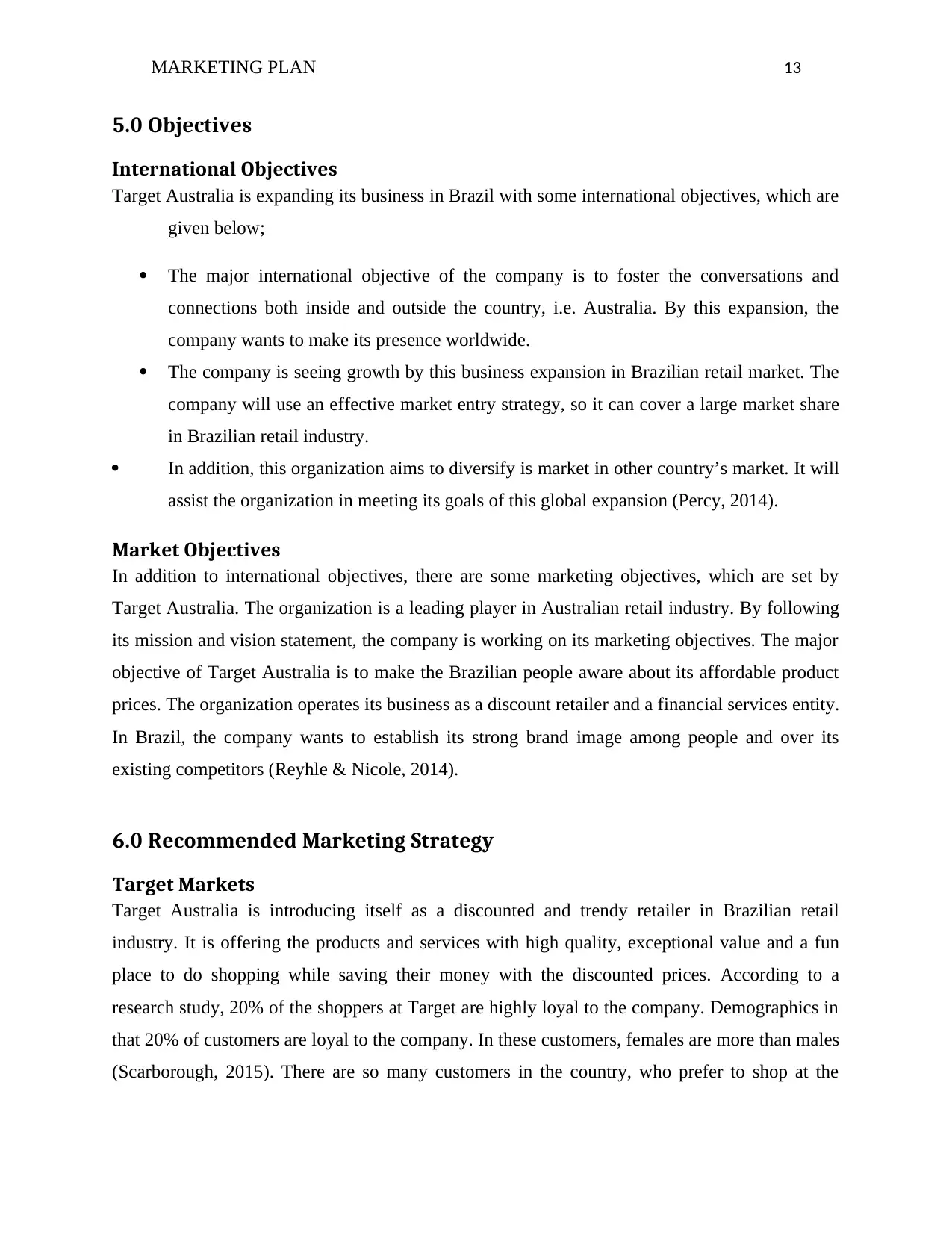
MARKETING PLAN 13
5.0 Objectives
International Objectives
Target Australia is expanding its business in Brazil with some international objectives, which are
given below;
The major international objective of the company is to foster the conversations and
connections both inside and outside the country, i.e. Australia. By this expansion, the
company wants to make its presence worldwide.
The company is seeing growth by this business expansion in Brazilian retail market. The
company will use an effective market entry strategy, so it can cover a large market share
in Brazilian retail industry.
In addition, this organization aims to diversify is market in other country’s market. It will
assist the organization in meeting its goals of this global expansion (Percy, 2014).
Market Objectives
In addition to international objectives, there are some marketing objectives, which are set by
Target Australia. The organization is a leading player in Australian retail industry. By following
its mission and vision statement, the company is working on its marketing objectives. The major
objective of Target Australia is to make the Brazilian people aware about its affordable product
prices. The organization operates its business as a discount retailer and a financial services entity.
In Brazil, the company wants to establish its strong brand image among people and over its
existing competitors (Reyhle & Nicole, 2014).
6.0 Recommended Marketing Strategy
Target Markets
Target Australia is introducing itself as a discounted and trendy retailer in Brazilian retail
industry. It is offering the products and services with high quality, exceptional value and a fun
place to do shopping while saving their money with the discounted prices. According to a
research study, 20% of the shoppers at Target are highly loyal to the company. Demographics in
that 20% of customers are loyal to the company. In these customers, females are more than males
(Scarborough, 2015). There are so many customers in the country, who prefer to shop at the
5.0 Objectives
International Objectives
Target Australia is expanding its business in Brazil with some international objectives, which are
given below;
The major international objective of the company is to foster the conversations and
connections both inside and outside the country, i.e. Australia. By this expansion, the
company wants to make its presence worldwide.
The company is seeing growth by this business expansion in Brazilian retail market. The
company will use an effective market entry strategy, so it can cover a large market share
in Brazilian retail industry.
In addition, this organization aims to diversify is market in other country’s market. It will
assist the organization in meeting its goals of this global expansion (Percy, 2014).
Market Objectives
In addition to international objectives, there are some marketing objectives, which are set by
Target Australia. The organization is a leading player in Australian retail industry. By following
its mission and vision statement, the company is working on its marketing objectives. The major
objective of Target Australia is to make the Brazilian people aware about its affordable product
prices. The organization operates its business as a discount retailer and a financial services entity.
In Brazil, the company wants to establish its strong brand image among people and over its
existing competitors (Reyhle & Nicole, 2014).
6.0 Recommended Marketing Strategy
Target Markets
Target Australia is introducing itself as a discounted and trendy retailer in Brazilian retail
industry. It is offering the products and services with high quality, exceptional value and a fun
place to do shopping while saving their money with the discounted prices. According to a
research study, 20% of the shoppers at Target are highly loyal to the company. Demographics in
that 20% of customers are loyal to the company. In these customers, females are more than males
(Scarborough, 2015). There are so many customers in the country, who prefer to shop at the
Paraphrase This Document
Need a fresh take? Get an instant paraphrase of this document with our AI Paraphraser
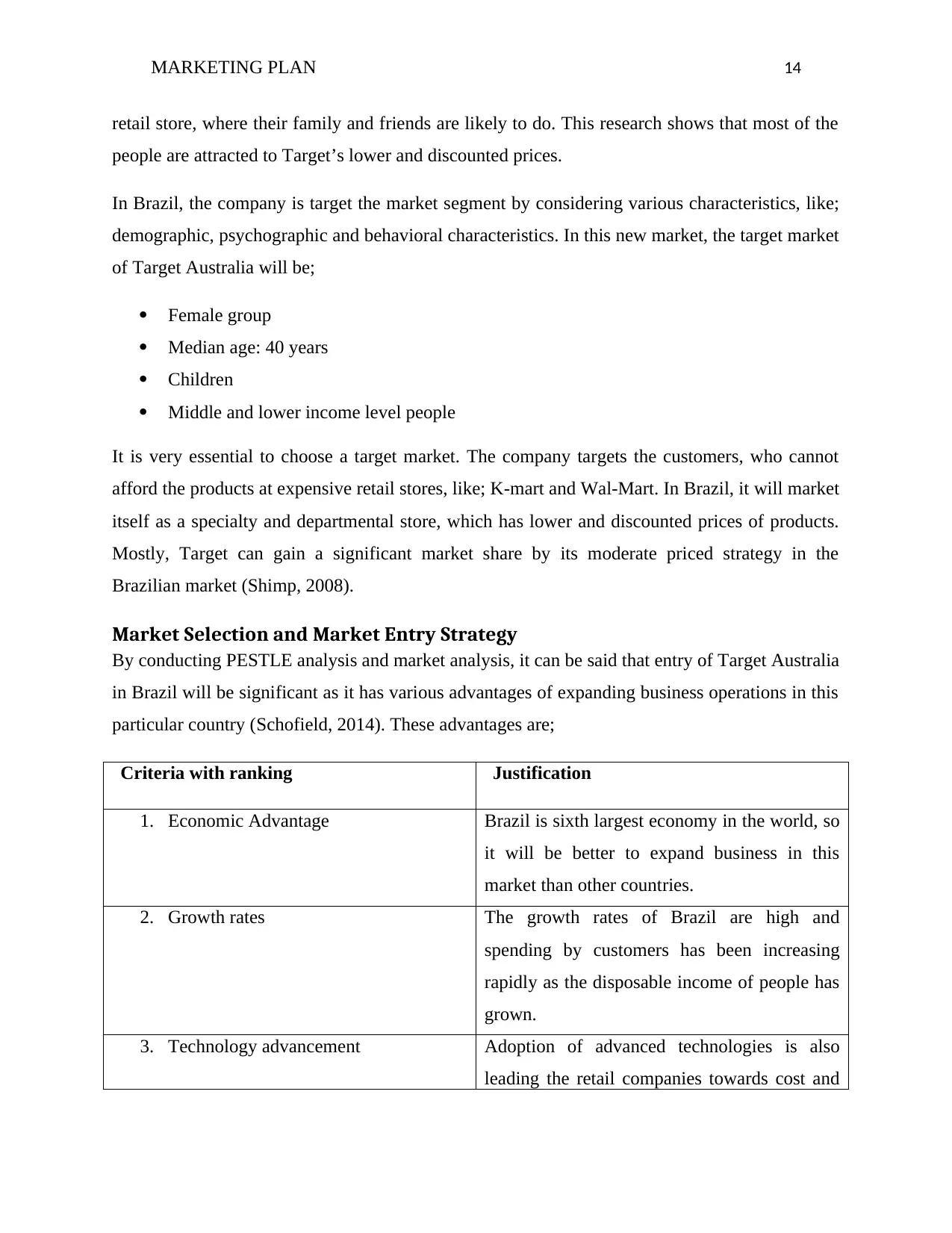
MARKETING PLAN 14
retail store, where their family and friends are likely to do. This research shows that most of the
people are attracted to Target’s lower and discounted prices.
In Brazil, the company is target the market segment by considering various characteristics, like;
demographic, psychographic and behavioral characteristics. In this new market, the target market
of Target Australia will be;
Female group
Median age: 40 years
Children
Middle and lower income level people
It is very essential to choose a target market. The company targets the customers, who cannot
afford the products at expensive retail stores, like; K-mart and Wal-Mart. In Brazil, it will market
itself as a specialty and departmental store, which has lower and discounted prices of products.
Mostly, Target can gain a significant market share by its moderate priced strategy in the
Brazilian market (Shimp, 2008).
Market Selection and Market Entry Strategy
By conducting PESTLE analysis and market analysis, it can be said that entry of Target Australia
in Brazil will be significant as it has various advantages of expanding business operations in this
particular country (Schofield, 2014). These advantages are;
Criteria with ranking Justification
1. Economic Advantage Brazil is sixth largest economy in the world, so
it will be better to expand business in this
market than other countries.
2. Growth rates The growth rates of Brazil are high and
spending by customers has been increasing
rapidly as the disposable income of people has
grown.
3. Technology advancement Adoption of advanced technologies is also
leading the retail companies towards cost and
retail store, where their family and friends are likely to do. This research shows that most of the
people are attracted to Target’s lower and discounted prices.
In Brazil, the company is target the market segment by considering various characteristics, like;
demographic, psychographic and behavioral characteristics. In this new market, the target market
of Target Australia will be;
Female group
Median age: 40 years
Children
Middle and lower income level people
It is very essential to choose a target market. The company targets the customers, who cannot
afford the products at expensive retail stores, like; K-mart and Wal-Mart. In Brazil, it will market
itself as a specialty and departmental store, which has lower and discounted prices of products.
Mostly, Target can gain a significant market share by its moderate priced strategy in the
Brazilian market (Shimp, 2008).
Market Selection and Market Entry Strategy
By conducting PESTLE analysis and market analysis, it can be said that entry of Target Australia
in Brazil will be significant as it has various advantages of expanding business operations in this
particular country (Schofield, 2014). These advantages are;
Criteria with ranking Justification
1. Economic Advantage Brazil is sixth largest economy in the world, so
it will be better to expand business in this
market than other countries.
2. Growth rates The growth rates of Brazil are high and
spending by customers has been increasing
rapidly as the disposable income of people has
grown.
3. Technology advancement Adoption of advanced technologies is also
leading the retail companies towards cost and
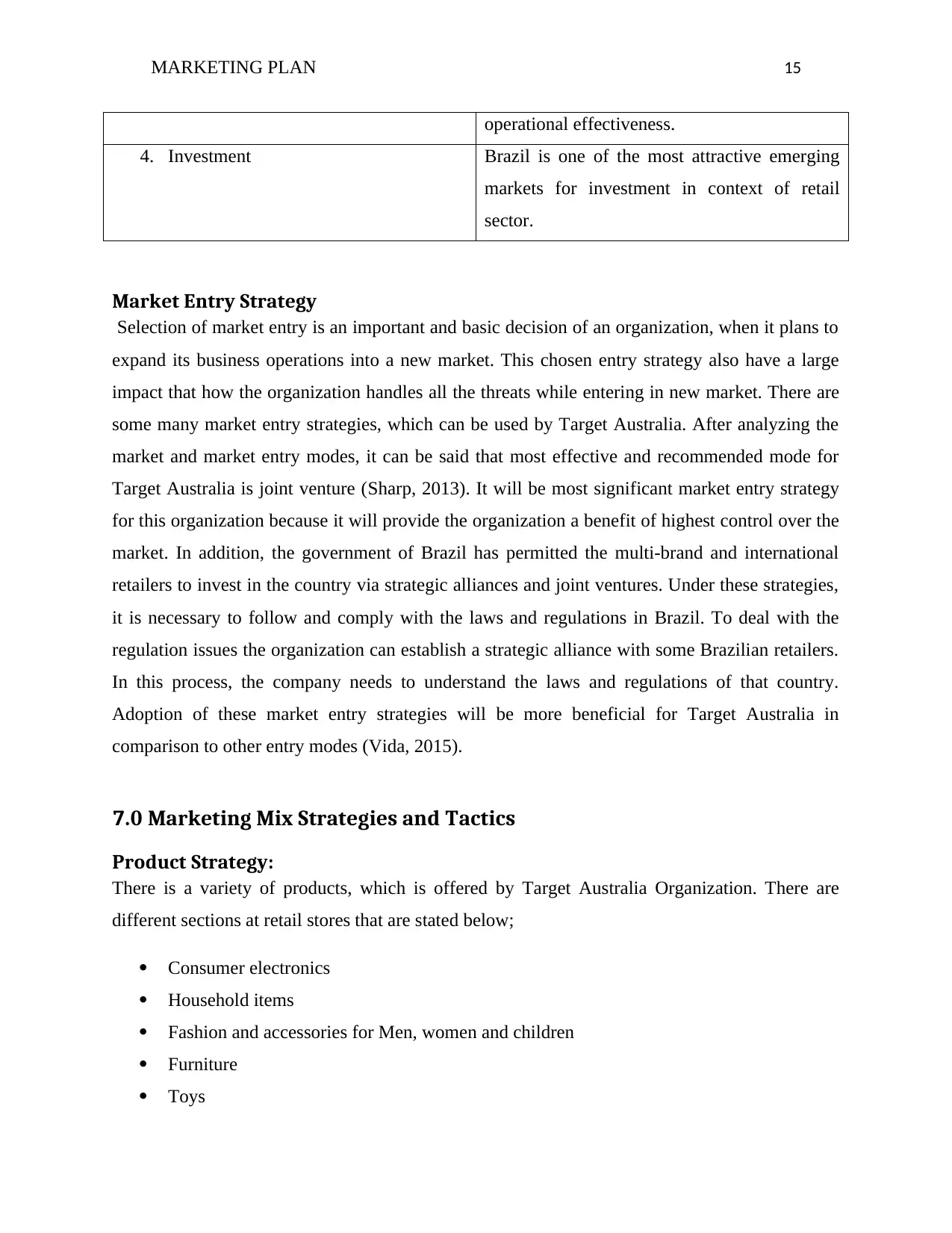
MARKETING PLAN 15
operational effectiveness.
4. Investment Brazil is one of the most attractive emerging
markets for investment in context of retail
sector.
Market Entry Strategy
Selection of market entry is an important and basic decision of an organization, when it plans to
expand its business operations into a new market. This chosen entry strategy also have a large
impact that how the organization handles all the threats while entering in new market. There are
some many market entry strategies, which can be used by Target Australia. After analyzing the
market and market entry modes, it can be said that most effective and recommended mode for
Target Australia is joint venture (Sharp, 2013). It will be most significant market entry strategy
for this organization because it will provide the organization a benefit of highest control over the
market. In addition, the government of Brazil has permitted the multi-brand and international
retailers to invest in the country via strategic alliances and joint ventures. Under these strategies,
it is necessary to follow and comply with the laws and regulations in Brazil. To deal with the
regulation issues the organization can establish a strategic alliance with some Brazilian retailers.
In this process, the company needs to understand the laws and regulations of that country.
Adoption of these market entry strategies will be more beneficial for Target Australia in
comparison to other entry modes (Vida, 2015).
7.0 Marketing Mix Strategies and Tactics
Product Strategy:
There is a variety of products, which is offered by Target Australia Organization. There are
different sections at retail stores that are stated below;
Consumer electronics
Household items
Fashion and accessories for Men, women and children
Furniture
Toys
operational effectiveness.
4. Investment Brazil is one of the most attractive emerging
markets for investment in context of retail
sector.
Market Entry Strategy
Selection of market entry is an important and basic decision of an organization, when it plans to
expand its business operations into a new market. This chosen entry strategy also have a large
impact that how the organization handles all the threats while entering in new market. There are
some many market entry strategies, which can be used by Target Australia. After analyzing the
market and market entry modes, it can be said that most effective and recommended mode for
Target Australia is joint venture (Sharp, 2013). It will be most significant market entry strategy
for this organization because it will provide the organization a benefit of highest control over the
market. In addition, the government of Brazil has permitted the multi-brand and international
retailers to invest in the country via strategic alliances and joint ventures. Under these strategies,
it is necessary to follow and comply with the laws and regulations in Brazil. To deal with the
regulation issues the organization can establish a strategic alliance with some Brazilian retailers.
In this process, the company needs to understand the laws and regulations of that country.
Adoption of these market entry strategies will be more beneficial for Target Australia in
comparison to other entry modes (Vida, 2015).
7.0 Marketing Mix Strategies and Tactics
Product Strategy:
There is a variety of products, which is offered by Target Australia Organization. There are
different sections at retail stores that are stated below;
Consumer electronics
Household items
Fashion and accessories for Men, women and children
Furniture
Toys
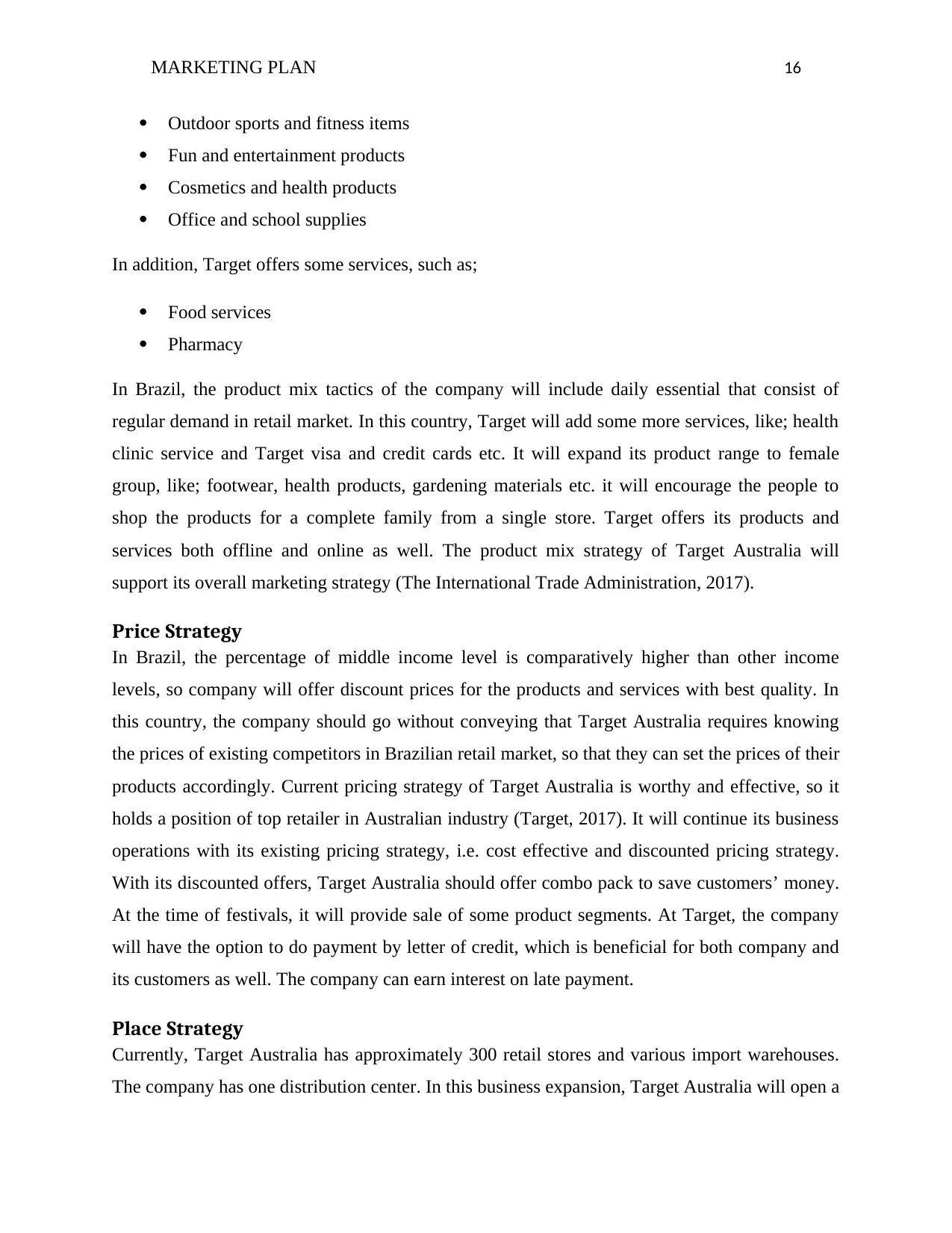
MARKETING PLAN 16
Outdoor sports and fitness items
Fun and entertainment products
Cosmetics and health products
Office and school supplies
In addition, Target offers some services, such as;
Food services
Pharmacy
In Brazil, the product mix tactics of the company will include daily essential that consist of
regular demand in retail market. In this country, Target will add some more services, like; health
clinic service and Target visa and credit cards etc. It will expand its product range to female
group, like; footwear, health products, gardening materials etc. it will encourage the people to
shop the products for a complete family from a single store. Target offers its products and
services both offline and online as well. The product mix strategy of Target Australia will
support its overall marketing strategy (The International Trade Administration, 2017).
Price Strategy
In Brazil, the percentage of middle income level is comparatively higher than other income
levels, so company will offer discount prices for the products and services with best quality. In
this country, the company should go without conveying that Target Australia requires knowing
the prices of existing competitors in Brazilian retail market, so that they can set the prices of their
products accordingly. Current pricing strategy of Target Australia is worthy and effective, so it
holds a position of top retailer in Australian industry (Target, 2017). It will continue its business
operations with its existing pricing strategy, i.e. cost effective and discounted pricing strategy.
With its discounted offers, Target Australia should offer combo pack to save customers’ money.
At the time of festivals, it will provide sale of some product segments. At Target, the company
will have the option to do payment by letter of credit, which is beneficial for both company and
its customers as well. The company can earn interest on late payment.
Place Strategy
Currently, Target Australia has approximately 300 retail stores and various import warehouses.
The company has one distribution center. In this business expansion, Target Australia will open a
Outdoor sports and fitness items
Fun and entertainment products
Cosmetics and health products
Office and school supplies
In addition, Target offers some services, such as;
Food services
Pharmacy
In Brazil, the product mix tactics of the company will include daily essential that consist of
regular demand in retail market. In this country, Target will add some more services, like; health
clinic service and Target visa and credit cards etc. It will expand its product range to female
group, like; footwear, health products, gardening materials etc. it will encourage the people to
shop the products for a complete family from a single store. Target offers its products and
services both offline and online as well. The product mix strategy of Target Australia will
support its overall marketing strategy (The International Trade Administration, 2017).
Price Strategy
In Brazil, the percentage of middle income level is comparatively higher than other income
levels, so company will offer discount prices for the products and services with best quality. In
this country, the company should go without conveying that Target Australia requires knowing
the prices of existing competitors in Brazilian retail market, so that they can set the prices of their
products accordingly. Current pricing strategy of Target Australia is worthy and effective, so it
holds a position of top retailer in Australian industry (Target, 2017). It will continue its business
operations with its existing pricing strategy, i.e. cost effective and discounted pricing strategy.
With its discounted offers, Target Australia should offer combo pack to save customers’ money.
At the time of festivals, it will provide sale of some product segments. At Target, the company
will have the option to do payment by letter of credit, which is beneficial for both company and
its customers as well. The company can earn interest on late payment.
Place Strategy
Currently, Target Australia has approximately 300 retail stores and various import warehouses.
The company has one distribution center. In this business expansion, Target Australia will open a
Secure Best Marks with AI Grader
Need help grading? Try our AI Grader for instant feedback on your assignments.
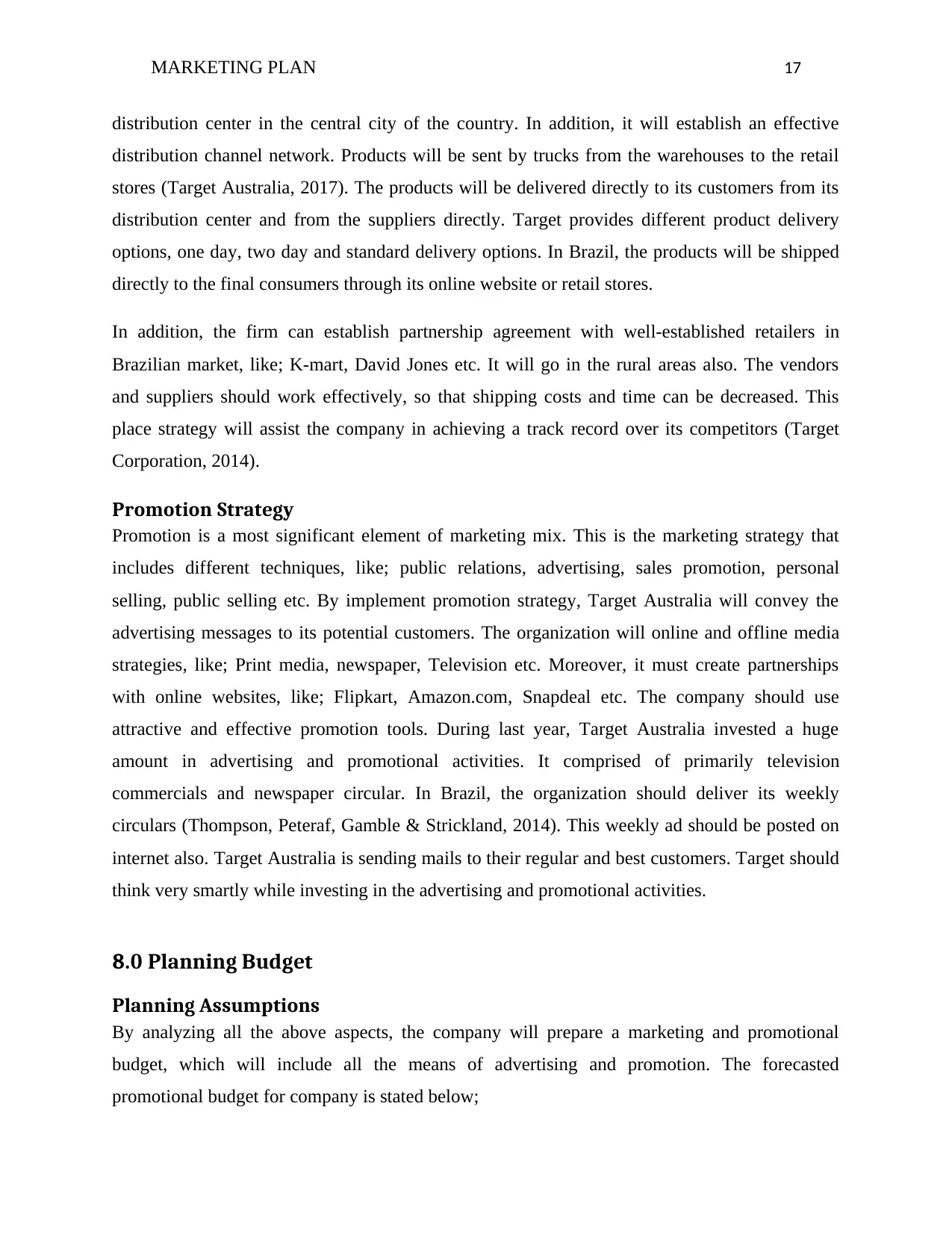
MARKETING PLAN 17
distribution center in the central city of the country. In addition, it will establish an effective
distribution channel network. Products will be sent by trucks from the warehouses to the retail
stores (Target Australia, 2017). The products will be delivered directly to its customers from its
distribution center and from the suppliers directly. Target provides different product delivery
options, one day, two day and standard delivery options. In Brazil, the products will be shipped
directly to the final consumers through its online website or retail stores.
In addition, the firm can establish partnership agreement with well-established retailers in
Brazilian market, like; K-mart, David Jones etc. It will go in the rural areas also. The vendors
and suppliers should work effectively, so that shipping costs and time can be decreased. This
place strategy will assist the company in achieving a track record over its competitors (Target
Corporation, 2014).
Promotion Strategy
Promotion is a most significant element of marketing mix. This is the marketing strategy that
includes different techniques, like; public relations, advertising, sales promotion, personal
selling, public selling etc. By implement promotion strategy, Target Australia will convey the
advertising messages to its potential customers. The organization will online and offline media
strategies, like; Print media, newspaper, Television etc. Moreover, it must create partnerships
with online websites, like; Flipkart, Amazon.com, Snapdeal etc. The company should use
attractive and effective promotion tools. During last year, Target Australia invested a huge
amount in advertising and promotional activities. It comprised of primarily television
commercials and newspaper circular. In Brazil, the organization should deliver its weekly
circulars (Thompson, Peteraf, Gamble & Strickland, 2014). This weekly ad should be posted on
internet also. Target Australia is sending mails to their regular and best customers. Target should
think very smartly while investing in the advertising and promotional activities.
8.0 Planning Budget
Planning Assumptions
By analyzing all the above aspects, the company will prepare a marketing and promotional
budget, which will include all the means of advertising and promotion. The forecasted
promotional budget for company is stated below;
distribution center in the central city of the country. In addition, it will establish an effective
distribution channel network. Products will be sent by trucks from the warehouses to the retail
stores (Target Australia, 2017). The products will be delivered directly to its customers from its
distribution center and from the suppliers directly. Target provides different product delivery
options, one day, two day and standard delivery options. In Brazil, the products will be shipped
directly to the final consumers through its online website or retail stores.
In addition, the firm can establish partnership agreement with well-established retailers in
Brazilian market, like; K-mart, David Jones etc. It will go in the rural areas also. The vendors
and suppliers should work effectively, so that shipping costs and time can be decreased. This
place strategy will assist the company in achieving a track record over its competitors (Target
Corporation, 2014).
Promotion Strategy
Promotion is a most significant element of marketing mix. This is the marketing strategy that
includes different techniques, like; public relations, advertising, sales promotion, personal
selling, public selling etc. By implement promotion strategy, Target Australia will convey the
advertising messages to its potential customers. The organization will online and offline media
strategies, like; Print media, newspaper, Television etc. Moreover, it must create partnerships
with online websites, like; Flipkart, Amazon.com, Snapdeal etc. The company should use
attractive and effective promotion tools. During last year, Target Australia invested a huge
amount in advertising and promotional activities. It comprised of primarily television
commercials and newspaper circular. In Brazil, the organization should deliver its weekly
circulars (Thompson, Peteraf, Gamble & Strickland, 2014). This weekly ad should be posted on
internet also. Target Australia is sending mails to their regular and best customers. Target should
think very smartly while investing in the advertising and promotional activities.
8.0 Planning Budget
Planning Assumptions
By analyzing all the above aspects, the company will prepare a marketing and promotional
budget, which will include all the means of advertising and promotion. The forecasted
promotional budget for company is stated below;
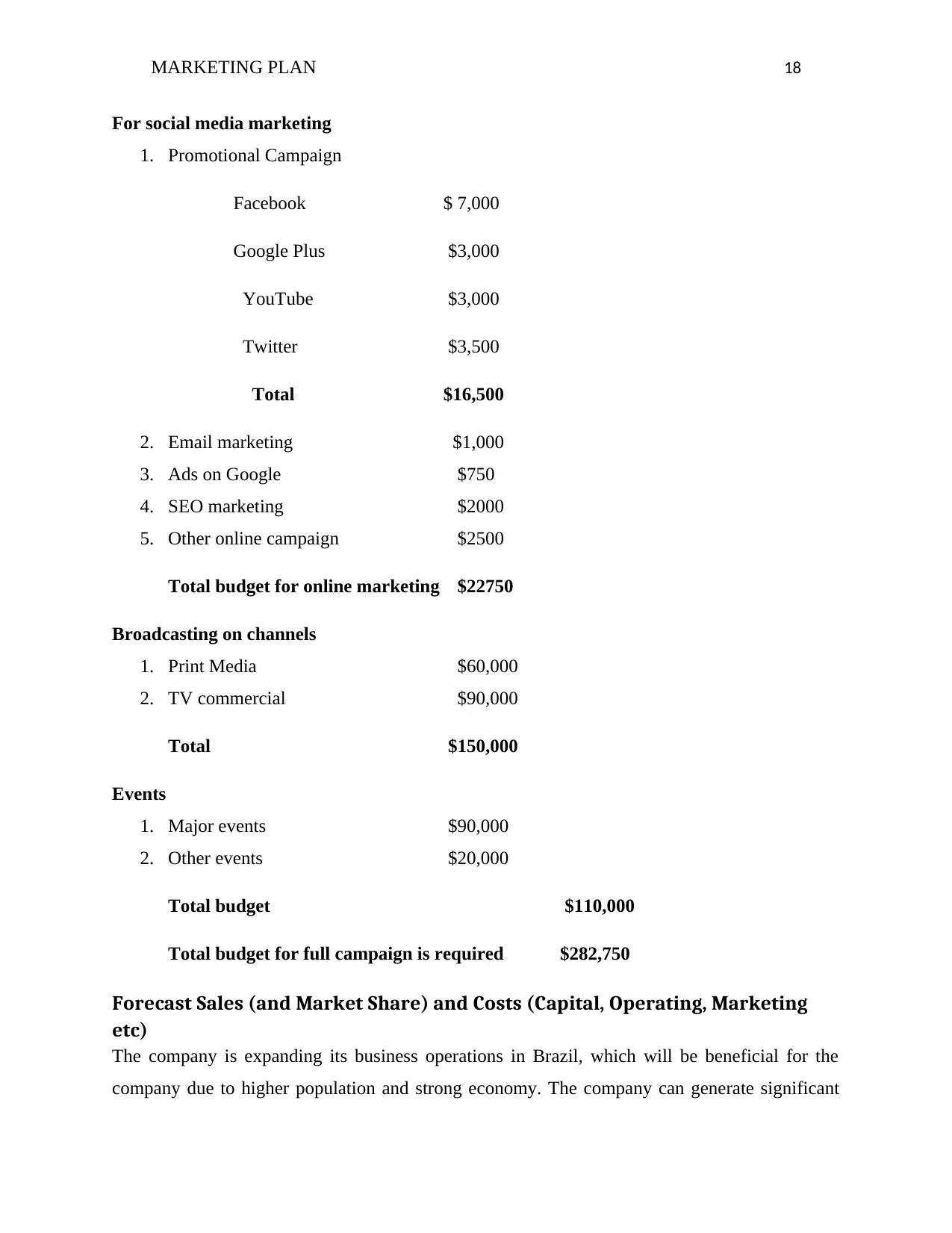
MARKETING PLAN 18
For social media marketing
1. Promotional Campaign
Facebook $ 7,000
Google Plus $3,000
YouTube $3,000
Twitter $3,500
Total $16,500
2. Email marketing $1,000
3. Ads on Google $750
4. SEO marketing $2000
5. Other online campaign $2500
Total budget for online marketing $22750
Broadcasting on channels
1. Print Media $60,000
2. TV commercial $90,000
Total $150,000
Events
1. Major events $90,000
2. Other events $20,000
Total budget $110,000
Total budget for full campaign is required $282,750
Forecast Sales (and Market Share) and Costs (Capital, Operating, Marketing
etc)
The company is expanding its business operations in Brazil, which will be beneficial for the
company due to higher population and strong economy. The company can generate significant
For social media marketing
1. Promotional Campaign
Facebook $ 7,000
Google Plus $3,000
YouTube $3,000
Twitter $3,500
Total $16,500
2. Email marketing $1,000
3. Ads on Google $750
4. SEO marketing $2000
5. Other online campaign $2500
Total budget for online marketing $22750
Broadcasting on channels
1. Print Media $60,000
2. TV commercial $90,000
Total $150,000
Events
1. Major events $90,000
2. Other events $20,000
Total budget $110,000
Total budget for full campaign is required $282,750
Forecast Sales (and Market Share) and Costs (Capital, Operating, Marketing
etc)
The company is expanding its business operations in Brazil, which will be beneficial for the
company due to higher population and strong economy. The company can generate significant
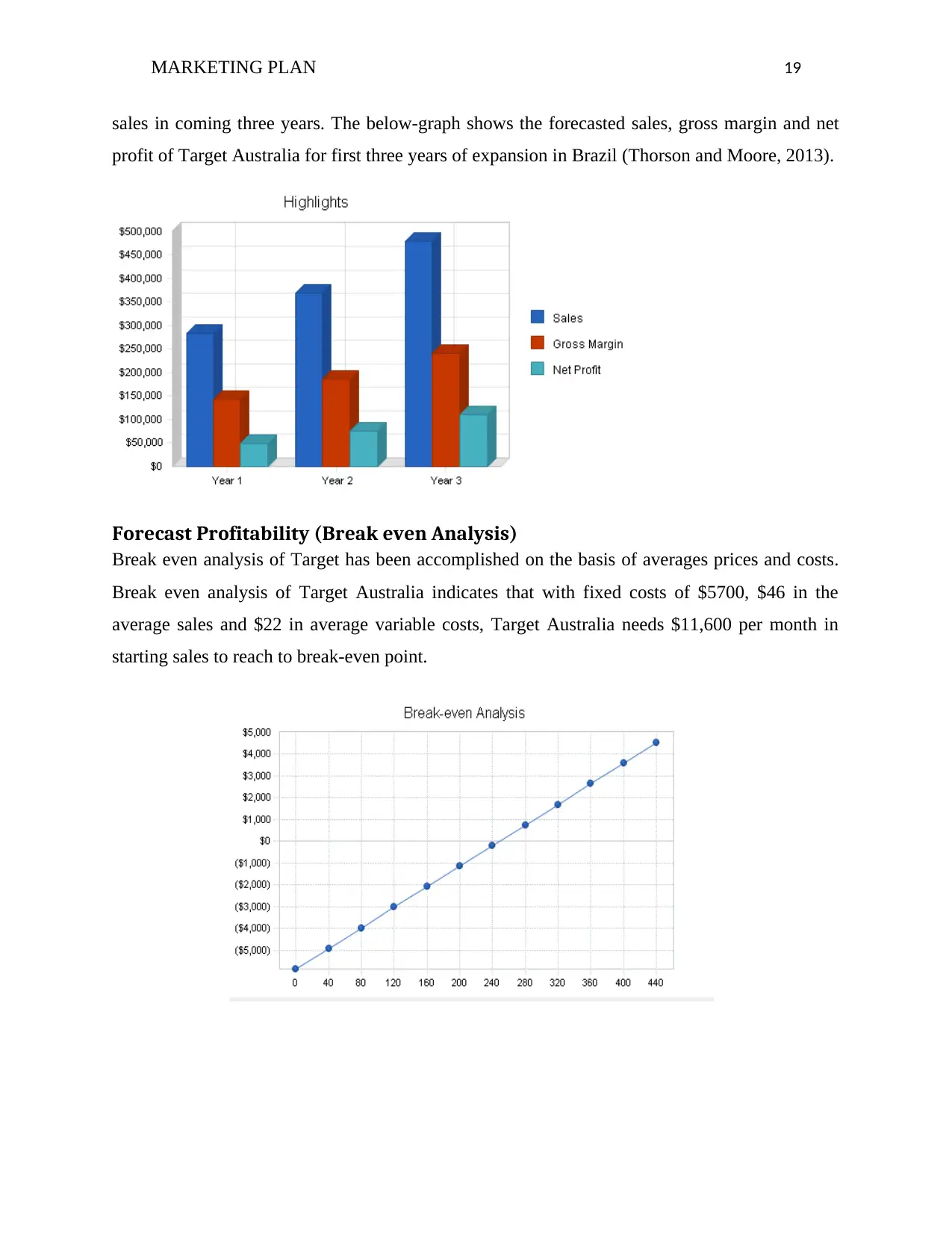
MARKETING PLAN 19
sales in coming three years. The below-graph shows the forecasted sales, gross margin and net
profit of Target Australia for first three years of expansion in Brazil (Thorson and Moore, 2013).
Forecast Profitability (Break even Analysis)
Break even analysis of Target has been accomplished on the basis of averages prices and costs.
Break even analysis of Target Australia indicates that with fixed costs of $5700, $46 in the
average sales and $22 in average variable costs, Target Australia needs $11,600 per month in
starting sales to reach to break-even point.
sales in coming three years. The below-graph shows the forecasted sales, gross margin and net
profit of Target Australia for first three years of expansion in Brazil (Thorson and Moore, 2013).
Forecast Profitability (Break even Analysis)
Break even analysis of Target has been accomplished on the basis of averages prices and costs.
Break even analysis of Target Australia indicates that with fixed costs of $5700, $46 in the
average sales and $22 in average variable costs, Target Australia needs $11,600 per month in
starting sales to reach to break-even point.
Paraphrase This Document
Need a fresh take? Get an instant paraphrase of this document with our AI Paraphraser
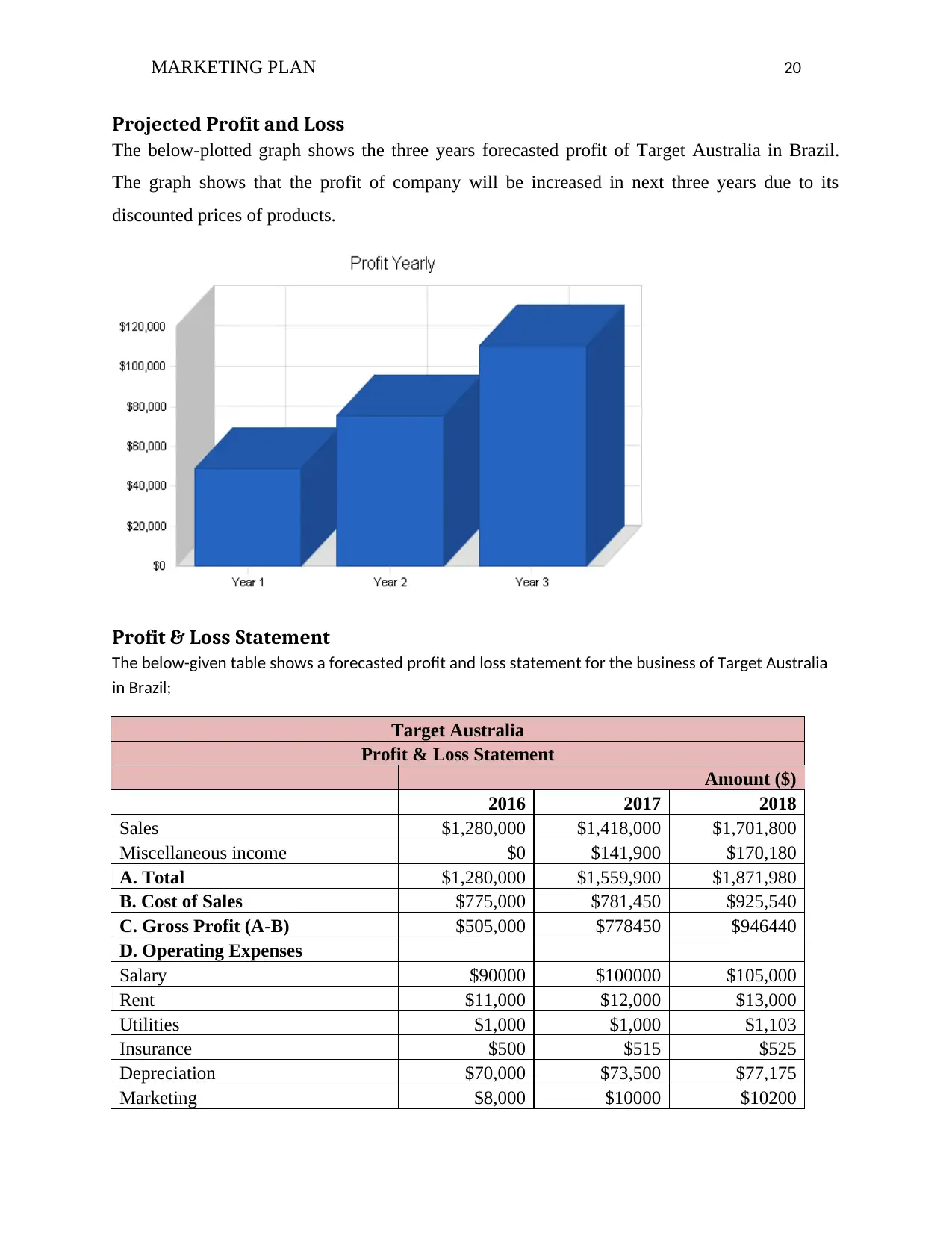
MARKETING PLAN 20
Projected Profit and Loss
The below-plotted graph shows the three years forecasted profit of Target Australia in Brazil.
The graph shows that the profit of company will be increased in next three years due to its
discounted prices of products.
Profit & Loss Statement
The below-given table shows a forecasted profit and loss statement for the business of Target Australia
in Brazil;
Target Australia
Profit & Loss Statement
Amount ($)
2016 2017 2018
Sales $1,280,000 $1,418,000 $1,701,800
Miscellaneous income $0 $141,900 $170,180
A. Total $1,280,000 $1,559,900 $1,871,980
B. Cost of Sales $775,000 $781,450 $925,540
C. Gross Profit (A-B) $505,000 $778450 $946440
D. Operating Expenses
Salary $90000 $100000 $105,000
Rent $11,000 $12,000 $13,000
Utilities $1,000 $1,000 $1,103
Insurance $500 $515 $525
Depreciation $70,000 $73,500 $77,175
Marketing $8,000 $10000 $10200
Projected Profit and Loss
The below-plotted graph shows the three years forecasted profit of Target Australia in Brazil.
The graph shows that the profit of company will be increased in next three years due to its
discounted prices of products.
Profit & Loss Statement
The below-given table shows a forecasted profit and loss statement for the business of Target Australia
in Brazil;
Target Australia
Profit & Loss Statement
Amount ($)
2016 2017 2018
Sales $1,280,000 $1,418,000 $1,701,800
Miscellaneous income $0 $141,900 $170,180
A. Total $1,280,000 $1,559,900 $1,871,980
B. Cost of Sales $775,000 $781,450 $925,540
C. Gross Profit (A-B) $505,000 $778450 $946440
D. Operating Expenses
Salary $90000 $100000 $105,000
Rent $11,000 $12,000 $13,000
Utilities $1,000 $1,000 $1,103
Insurance $500 $515 $525
Depreciation $70,000 $73,500 $77,175
Marketing $8,000 $10000 $10200
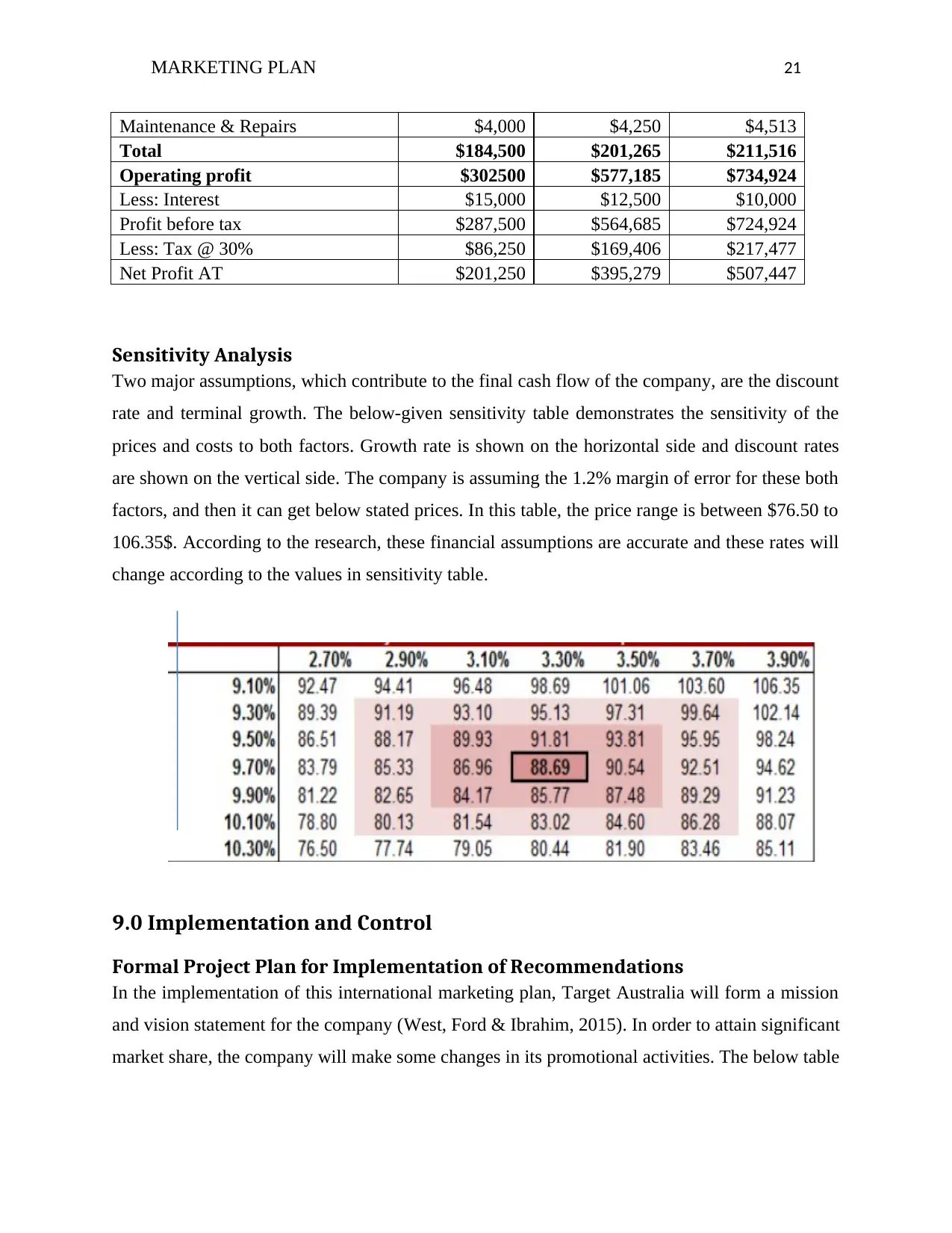
MARKETING PLAN 21
Maintenance & Repairs $4,000 $4,250 $4,513
Total $184,500 $201,265 $211,516
Operating profit $302500 $577,185 $734,924
Less: Interest $15,000 $12,500 $10,000
Profit before tax $287,500 $564,685 $724,924
Less: Tax @ 30% $86,250 $169,406 $217,477
Net Profit AT $201,250 $395,279 $507,447
Sensitivity Analysis
Two major assumptions, which contribute to the final cash flow of the company, are the discount
rate and terminal growth. The below-given sensitivity table demonstrates the sensitivity of the
prices and costs to both factors. Growth rate is shown on the horizontal side and discount rates
are shown on the vertical side. The company is assuming the 1.2% margin of error for these both
factors, and then it can get below stated prices. In this table, the price range is between $76.50 to
106.35$. According to the research, these financial assumptions are accurate and these rates will
change according to the values in sensitivity table.
9.0 Implementation and Control
Formal Project Plan for Implementation of Recommendations
In the implementation of this international marketing plan, Target Australia will form a mission
and vision statement for the company (West, Ford & Ibrahim, 2015). In order to attain significant
market share, the company will make some changes in its promotional activities. The below table
Maintenance & Repairs $4,000 $4,250 $4,513
Total $184,500 $201,265 $211,516
Operating profit $302500 $577,185 $734,924
Less: Interest $15,000 $12,500 $10,000
Profit before tax $287,500 $564,685 $724,924
Less: Tax @ 30% $86,250 $169,406 $217,477
Net Profit AT $201,250 $395,279 $507,447
Sensitivity Analysis
Two major assumptions, which contribute to the final cash flow of the company, are the discount
rate and terminal growth. The below-given sensitivity table demonstrates the sensitivity of the
prices and costs to both factors. Growth rate is shown on the horizontal side and discount rates
are shown on the vertical side. The company is assuming the 1.2% margin of error for these both
factors, and then it can get below stated prices. In this table, the price range is between $76.50 to
106.35$. According to the research, these financial assumptions are accurate and these rates will
change according to the values in sensitivity table.
9.0 Implementation and Control
Formal Project Plan for Implementation of Recommendations
In the implementation of this international marketing plan, Target Australia will form a mission
and vision statement for the company (West, Ford & Ibrahim, 2015). In order to attain significant
market share, the company will make some changes in its promotional activities. The below table
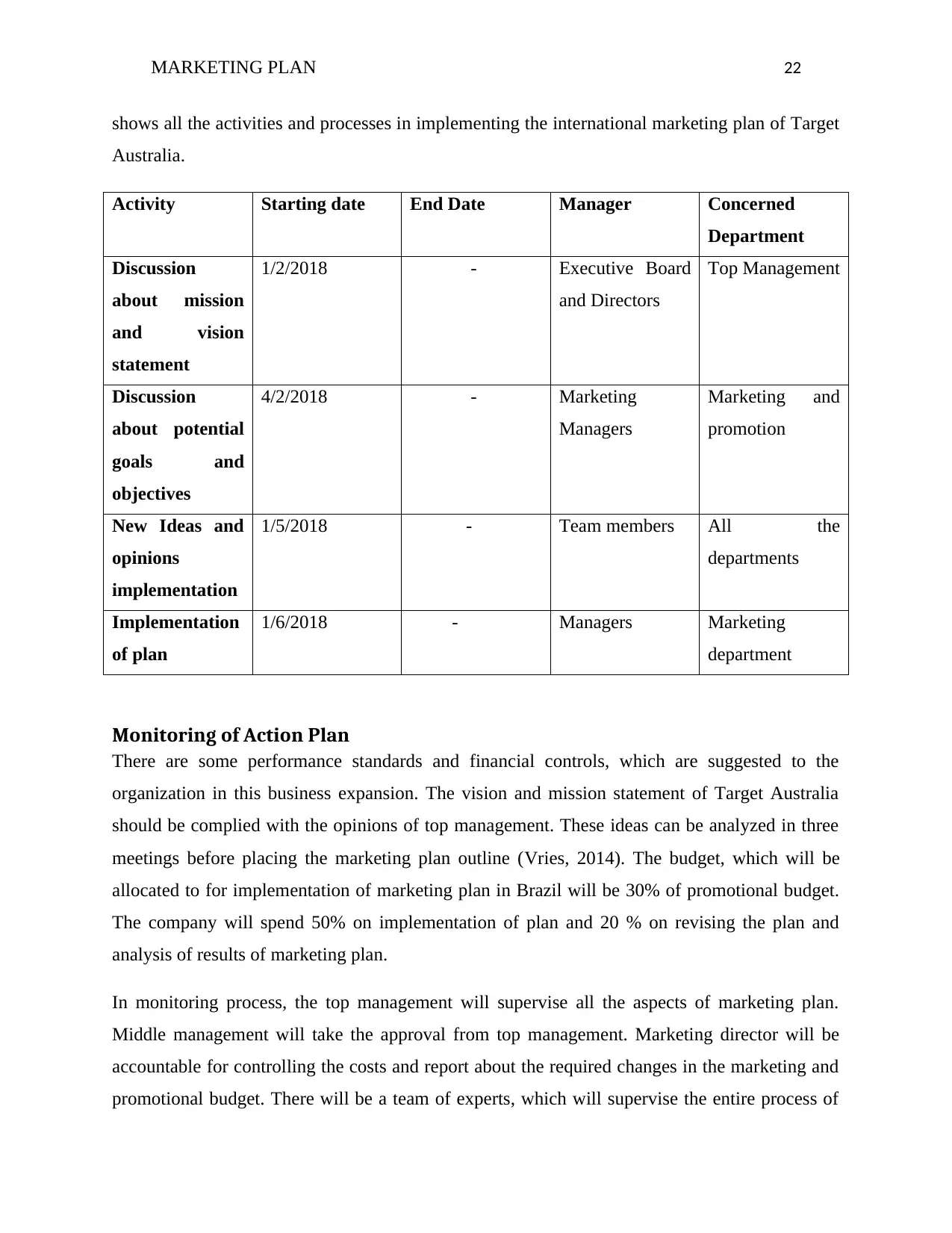
MARKETING PLAN 22
shows all the activities and processes in implementing the international marketing plan of Target
Australia.
Activity Starting date End Date Manager Concerned
Department
Discussion
about mission
and vision
statement
1/2/2018 - Executive Board
and Directors
Top Management
Discussion
about potential
goals and
objectives
4/2/2018 - Marketing
Managers
Marketing and
promotion
New Ideas and
opinions
implementation
1/5/2018 - Team members All the
departments
Implementation
of plan
1/6/2018 - Managers Marketing
department
Monitoring of Action Plan
There are some performance standards and financial controls, which are suggested to the
organization in this business expansion. The vision and mission statement of Target Australia
should be complied with the opinions of top management. These ideas can be analyzed in three
meetings before placing the marketing plan outline (Vries, 2014). The budget, which will be
allocated to for implementation of marketing plan in Brazil will be 30% of promotional budget.
The company will spend 50% on implementation of plan and 20 % on revising the plan and
analysis of results of marketing plan.
In monitoring process, the top management will supervise all the aspects of marketing plan.
Middle management will take the approval from top management. Marketing director will be
accountable for controlling the costs and report about the required changes in the marketing and
promotional budget. There will be a team of experts, which will supervise the entire process of
shows all the activities and processes in implementing the international marketing plan of Target
Australia.
Activity Starting date End Date Manager Concerned
Department
Discussion
about mission
and vision
statement
1/2/2018 - Executive Board
and Directors
Top Management
Discussion
about potential
goals and
objectives
4/2/2018 - Marketing
Managers
Marketing and
promotion
New Ideas and
opinions
implementation
1/5/2018 - Team members All the
departments
Implementation
of plan
1/6/2018 - Managers Marketing
department
Monitoring of Action Plan
There are some performance standards and financial controls, which are suggested to the
organization in this business expansion. The vision and mission statement of Target Australia
should be complied with the opinions of top management. These ideas can be analyzed in three
meetings before placing the marketing plan outline (Vries, 2014). The budget, which will be
allocated to for implementation of marketing plan in Brazil will be 30% of promotional budget.
The company will spend 50% on implementation of plan and 20 % on revising the plan and
analysis of results of marketing plan.
In monitoring process, the top management will supervise all the aspects of marketing plan.
Middle management will take the approval from top management. Marketing director will be
accountable for controlling the costs and report about the required changes in the marketing and
promotional budget. There will be a team of experts, which will supervise the entire process of
Secure Best Marks with AI Grader
Need help grading? Try our AI Grader for instant feedback on your assignments.
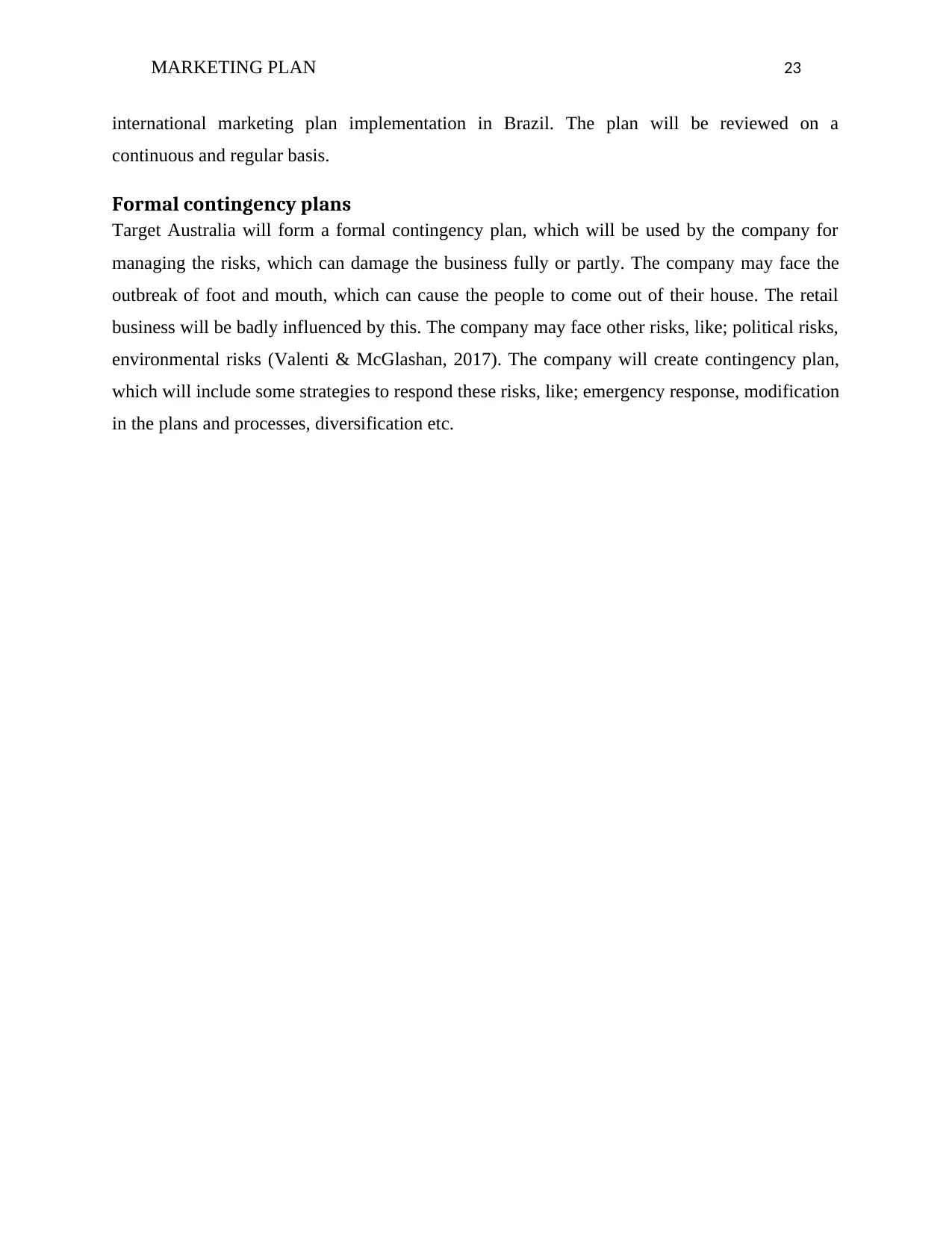
MARKETING PLAN 23
international marketing plan implementation in Brazil. The plan will be reviewed on a
continuous and regular basis.
Formal contingency plans
Target Australia will form a formal contingency plan, which will be used by the company for
managing the risks, which can damage the business fully or partly. The company may face the
outbreak of foot and mouth, which can cause the people to come out of their house. The retail
business will be badly influenced by this. The company may face other risks, like; political risks,
environmental risks (Valenti & McGlashan, 2017). The company will create contingency plan,
which will include some strategies to respond these risks, like; emergency response, modification
in the plans and processes, diversification etc.
international marketing plan implementation in Brazil. The plan will be reviewed on a
continuous and regular basis.
Formal contingency plans
Target Australia will form a formal contingency plan, which will be used by the company for
managing the risks, which can damage the business fully or partly. The company may face the
outbreak of foot and mouth, which can cause the people to come out of their house. The retail
business will be badly influenced by this. The company may face other risks, like; political risks,
environmental risks (Valenti & McGlashan, 2017). The company will create contingency plan,
which will include some strategies to respond these risks, like; emergency response, modification
in the plans and processes, diversification etc.
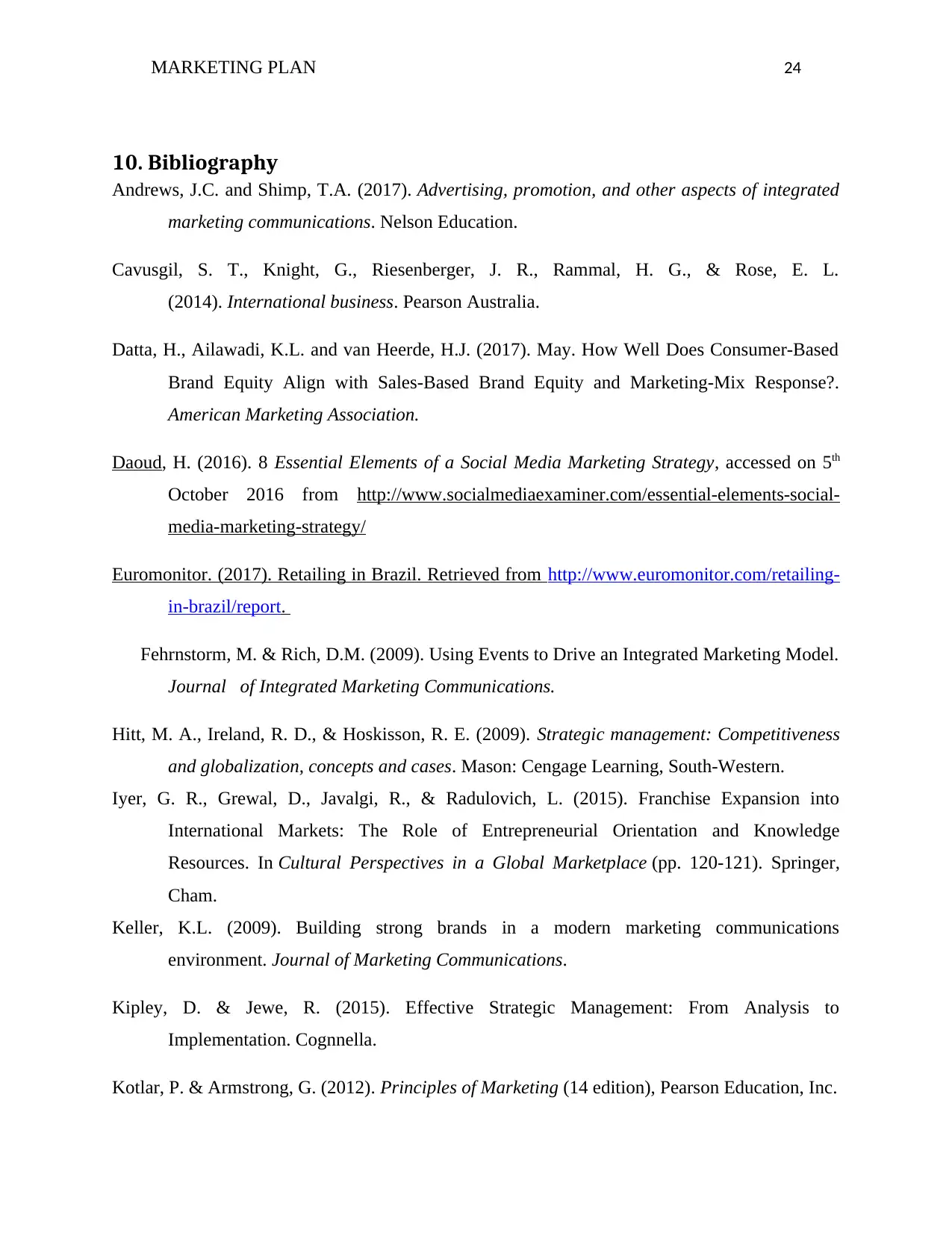
MARKETING PLAN 24
10. Bibliography
Andrews, J.C. and Shimp, T.A. (2017). Advertising, promotion, and other aspects of integrated
marketing communications. Nelson Education.
Cavusgil, S. T., Knight, G., Riesenberger, J. R., Rammal, H. G., & Rose, E. L.
(2014). International business. Pearson Australia.
Datta, H., Ailawadi, K.L. and van Heerde, H.J. (2017). May. How Well Does Consumer-Based
Brand Equity Align with Sales-Based Brand Equity and Marketing-Mix Response?.
American Marketing Association.
Daoud, H. (2016). 8 Essential Elements of a Social Media Marketing Strategy, accessed on 5th
October 2016 from http://www.socialmediaexaminer.com/essential-elements-social-
media-marketing-strategy/
Euromonitor. (2017). Retailing in Brazil. Retrieved from http://www.euromonitor.com/retailing-
in-brazil/report.
Fehrnstorm, M. & Rich, D.M. (2009). Using Events to Drive an Integrated Marketing Model.
Journal of Integrated Marketing Communications.
Hitt, M. A., Ireland, R. D., & Hoskisson, R. E. (2009). Strategic management: Competitiveness
and globalization, concepts and cases. Mason: Cengage Learning, South-Western.
Iyer, G. R., Grewal, D., Javalgi, R., & Radulovich, L. (2015). Franchise Expansion into
International Markets: The Role of Entrepreneurial Orientation and Knowledge
Resources. In Cultural Perspectives in a Global Marketplace (pp. 120-121). Springer,
Cham.
Keller, K.L. (2009). Building strong brands in a modern marketing communications
environment. Journal of Marketing Communications.
Kipley, D. & Jewe, R. (2015). Effective Strategic Management: From Analysis to
Implementation. Cognnella.
Kotlar, P. & Armstrong, G. (2012). Principles of Marketing (14 edition), Pearson Education, Inc.
10. Bibliography
Andrews, J.C. and Shimp, T.A. (2017). Advertising, promotion, and other aspects of integrated
marketing communications. Nelson Education.
Cavusgil, S. T., Knight, G., Riesenberger, J. R., Rammal, H. G., & Rose, E. L.
(2014). International business. Pearson Australia.
Datta, H., Ailawadi, K.L. and van Heerde, H.J. (2017). May. How Well Does Consumer-Based
Brand Equity Align with Sales-Based Brand Equity and Marketing-Mix Response?.
American Marketing Association.
Daoud, H. (2016). 8 Essential Elements of a Social Media Marketing Strategy, accessed on 5th
October 2016 from http://www.socialmediaexaminer.com/essential-elements-social-
media-marketing-strategy/
Euromonitor. (2017). Retailing in Brazil. Retrieved from http://www.euromonitor.com/retailing-
in-brazil/report.
Fehrnstorm, M. & Rich, D.M. (2009). Using Events to Drive an Integrated Marketing Model.
Journal of Integrated Marketing Communications.
Hitt, M. A., Ireland, R. D., & Hoskisson, R. E. (2009). Strategic management: Competitiveness
and globalization, concepts and cases. Mason: Cengage Learning, South-Western.
Iyer, G. R., Grewal, D., Javalgi, R., & Radulovich, L. (2015). Franchise Expansion into
International Markets: The Role of Entrepreneurial Orientation and Knowledge
Resources. In Cultural Perspectives in a Global Marketplace (pp. 120-121). Springer,
Cham.
Keller, K.L. (2009). Building strong brands in a modern marketing communications
environment. Journal of Marketing Communications.
Kipley, D. & Jewe, R. (2015). Effective Strategic Management: From Analysis to
Implementation. Cognnella.
Kotlar, P. & Armstrong, G. (2012). Principles of Marketing (14 edition), Pearson Education, Inc.
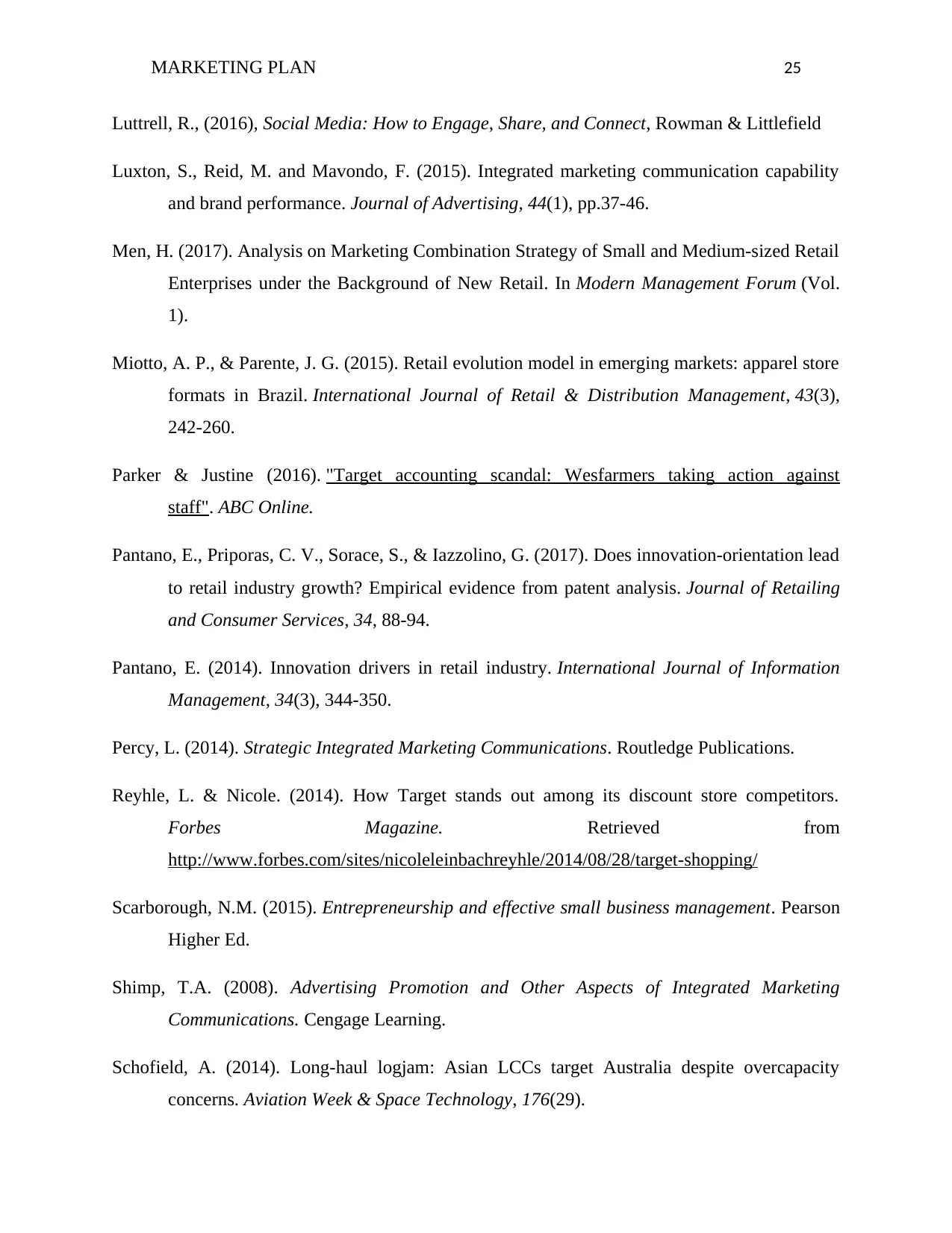
MARKETING PLAN 25
Luttrell, R., (2016), Social Media: How to Engage, Share, and Connect, Rowman & Littlefield
Luxton, S., Reid, M. and Mavondo, F. (2015). Integrated marketing communication capability
and brand performance. Journal of Advertising, 44(1), pp.37-46.
Men, H. (2017). Analysis on Marketing Combination Strategy of Small and Medium-sized Retail
Enterprises under the Background of New Retail. In Modern Management Forum (Vol.
1).
Miotto, A. P., & Parente, J. G. (2015). Retail evolution model in emerging markets: apparel store
formats in Brazil. International Journal of Retail & Distribution Management, 43(3),
242-260.
Parker & Justine (2016). "Target accounting scandal: Wesfarmers taking action against
staff". ABC Online.
Pantano, E., Priporas, C. V., Sorace, S., & Iazzolino, G. (2017). Does innovation-orientation lead
to retail industry growth? Empirical evidence from patent analysis. Journal of Retailing
and Consumer Services, 34, 88-94.
Pantano, E. (2014). Innovation drivers in retail industry. International Journal of Information
Management, 34(3), 344-350.
Percy, L. (2014). Strategic Integrated Marketing Communications. Routledge Publications.
Reyhle, L. & Nicole. (2014). How Target stands out among its discount store competitors.
Forbes Magazine. Retrieved from
http://www.forbes.com/sites/nicoleleinbachreyhle/2014/08/28/target-shopping/
Scarborough, N.M. (2015). Entrepreneurship and effective small business management. Pearson
Higher Ed.
Shimp, T.A. (2008). Advertising Promotion and Other Aspects of Integrated Marketing
Communications. Cengage Learning.
Schofield, A. (2014). Long-haul logjam: Asian LCCs target Australia despite overcapacity
concerns. Aviation Week & Space Technology, 176(29).
Luttrell, R., (2016), Social Media: How to Engage, Share, and Connect, Rowman & Littlefield
Luxton, S., Reid, M. and Mavondo, F. (2015). Integrated marketing communication capability
and brand performance. Journal of Advertising, 44(1), pp.37-46.
Men, H. (2017). Analysis on Marketing Combination Strategy of Small and Medium-sized Retail
Enterprises under the Background of New Retail. In Modern Management Forum (Vol.
1).
Miotto, A. P., & Parente, J. G. (2015). Retail evolution model in emerging markets: apparel store
formats in Brazil. International Journal of Retail & Distribution Management, 43(3),
242-260.
Parker & Justine (2016). "Target accounting scandal: Wesfarmers taking action against
staff". ABC Online.
Pantano, E., Priporas, C. V., Sorace, S., & Iazzolino, G. (2017). Does innovation-orientation lead
to retail industry growth? Empirical evidence from patent analysis. Journal of Retailing
and Consumer Services, 34, 88-94.
Pantano, E. (2014). Innovation drivers in retail industry. International Journal of Information
Management, 34(3), 344-350.
Percy, L. (2014). Strategic Integrated Marketing Communications. Routledge Publications.
Reyhle, L. & Nicole. (2014). How Target stands out among its discount store competitors.
Forbes Magazine. Retrieved from
http://www.forbes.com/sites/nicoleleinbachreyhle/2014/08/28/target-shopping/
Scarborough, N.M. (2015). Entrepreneurship and effective small business management. Pearson
Higher Ed.
Shimp, T.A. (2008). Advertising Promotion and Other Aspects of Integrated Marketing
Communications. Cengage Learning.
Schofield, A. (2014). Long-haul logjam: Asian LCCs target Australia despite overcapacity
concerns. Aviation Week & Space Technology, 176(29).
Paraphrase This Document
Need a fresh take? Get an instant paraphrase of this document with our AI Paraphraser
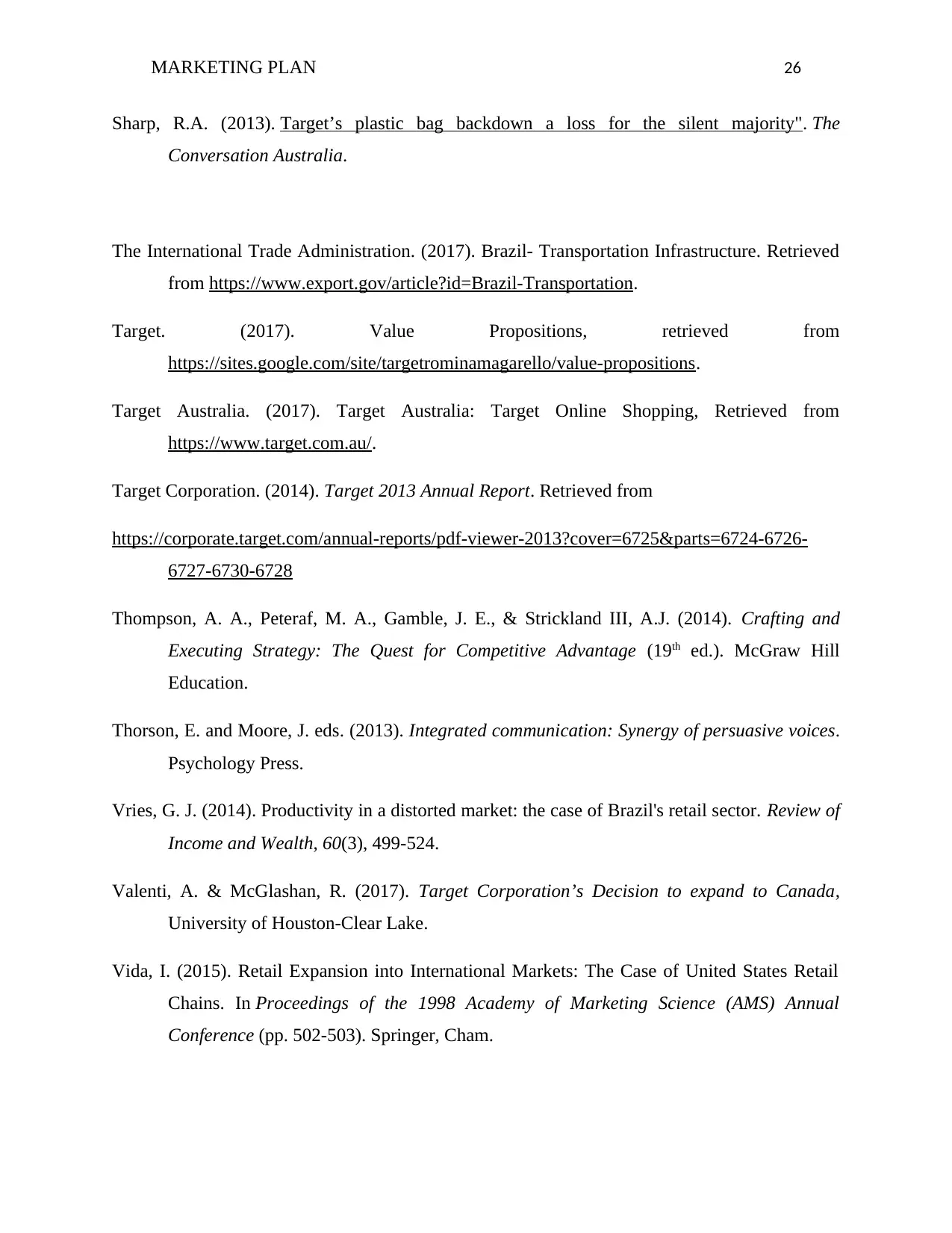
MARKETING PLAN 26
Sharp, R.A. (2013). Target’s plastic bag backdown a loss for the silent majority". The
Conversation Australia.
The International Trade Administration. (2017). Brazil- Transportation Infrastructure. Retrieved
from https://www.export.gov/article?id=Brazil-Transportation.
Target. (2017). Value Propositions, retrieved from
https://sites.google.com/site/targetrominamagarello/value-propositions.
Target Australia. (2017). Target Australia: Target Online Shopping, Retrieved from
https://www.target.com.au/.
Target Corporation. (2014). Target 2013 Annual Report. Retrieved from
https://corporate.target.com/annual-reports/pdf-viewer-2013?cover=6725&parts=6724-6726-
6727-6730-6728
Thompson, A. A., Peteraf, M. A., Gamble, J. E., & Strickland III, A.J. (2014). Crafting and
Executing Strategy: The Quest for Competitive Advantage (19th ed.). McGraw Hill
Education.
Thorson, E. and Moore, J. eds. (2013). Integrated communication: Synergy of persuasive voices.
Psychology Press.
Vries, G. J. (2014). Productivity in a distorted market: the case of Brazil's retail sector. Review of
Income and Wealth, 60(3), 499-524.
Valenti, A. & McGlashan, R. (2017). Target Corporation’s Decision to expand to Canada,
University of Houston-Clear Lake.
Vida, I. (2015). Retail Expansion into International Markets: The Case of United States Retail
Chains. In Proceedings of the 1998 Academy of Marketing Science (AMS) Annual
Conference (pp. 502-503). Springer, Cham.
Sharp, R.A. (2013). Target’s plastic bag backdown a loss for the silent majority". The
Conversation Australia.
The International Trade Administration. (2017). Brazil- Transportation Infrastructure. Retrieved
from https://www.export.gov/article?id=Brazil-Transportation.
Target. (2017). Value Propositions, retrieved from
https://sites.google.com/site/targetrominamagarello/value-propositions.
Target Australia. (2017). Target Australia: Target Online Shopping, Retrieved from
https://www.target.com.au/.
Target Corporation. (2014). Target 2013 Annual Report. Retrieved from
https://corporate.target.com/annual-reports/pdf-viewer-2013?cover=6725&parts=6724-6726-
6727-6730-6728
Thompson, A. A., Peteraf, M. A., Gamble, J. E., & Strickland III, A.J. (2014). Crafting and
Executing Strategy: The Quest for Competitive Advantage (19th ed.). McGraw Hill
Education.
Thorson, E. and Moore, J. eds. (2013). Integrated communication: Synergy of persuasive voices.
Psychology Press.
Vries, G. J. (2014). Productivity in a distorted market: the case of Brazil's retail sector. Review of
Income and Wealth, 60(3), 499-524.
Valenti, A. & McGlashan, R. (2017). Target Corporation’s Decision to expand to Canada,
University of Houston-Clear Lake.
Vida, I. (2015). Retail Expansion into International Markets: The Case of United States Retail
Chains. In Proceedings of the 1998 Academy of Marketing Science (AMS) Annual
Conference (pp. 502-503). Springer, Cham.
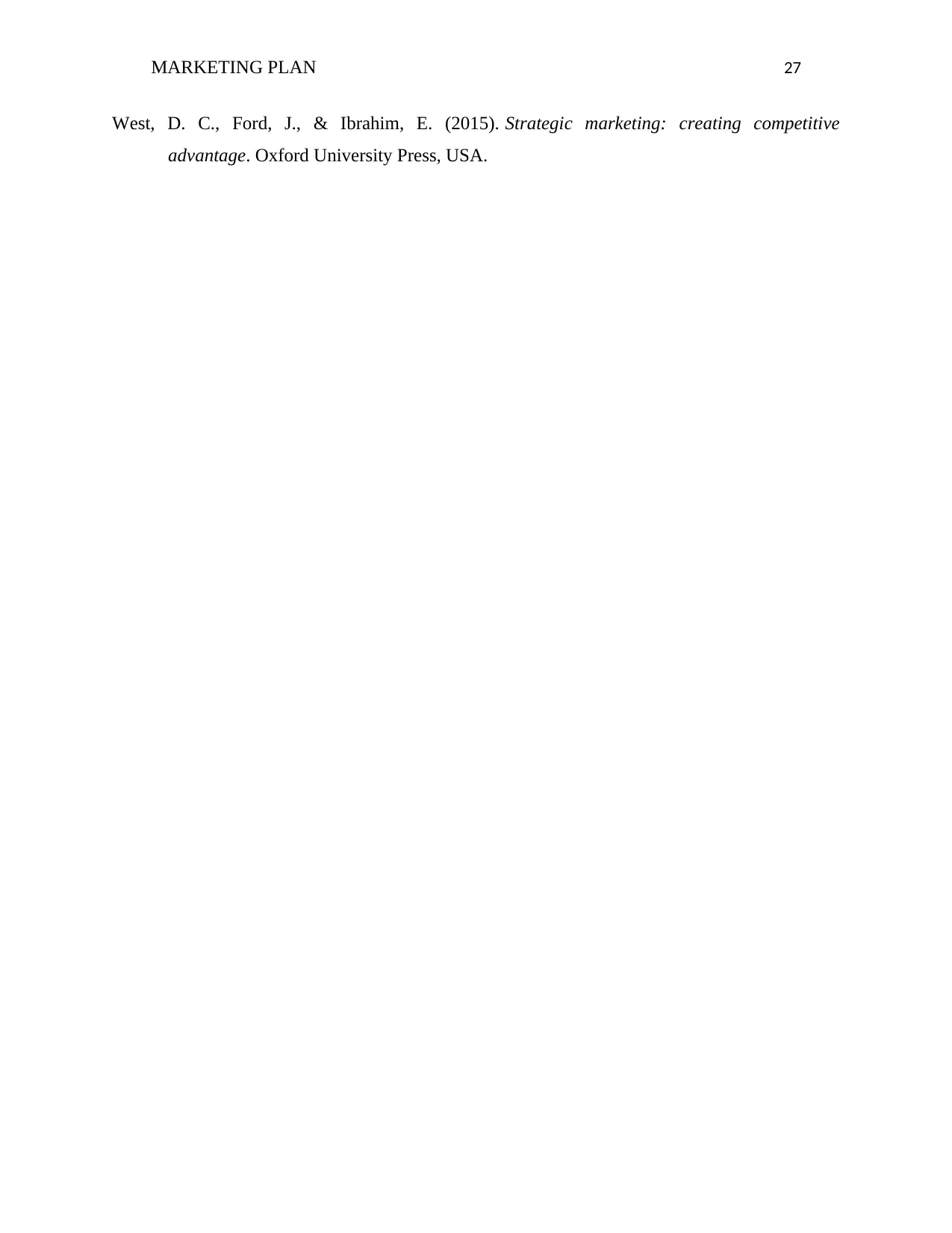
MARKETING PLAN 27
West, D. C., Ford, J., & Ibrahim, E. (2015). Strategic marketing: creating competitive
advantage. Oxford University Press, USA.
West, D. C., Ford, J., & Ibrahim, E. (2015). Strategic marketing: creating competitive
advantage. Oxford University Press, USA.
1 out of 27
Related Documents
Your All-in-One AI-Powered Toolkit for Academic Success.
+13062052269
info@desklib.com
Available 24*7 on WhatsApp / Email
![[object Object]](/_next/static/media/star-bottom.7253800d.svg)
Unlock your academic potential
© 2024 | Zucol Services PVT LTD | All rights reserved.





